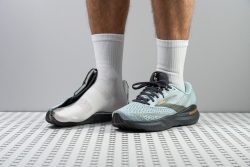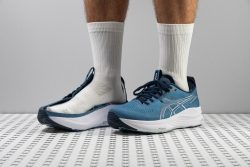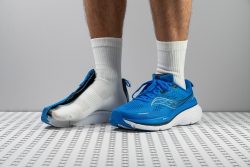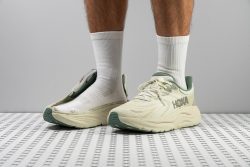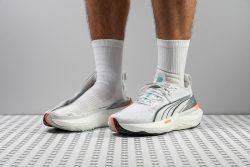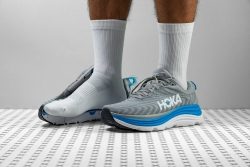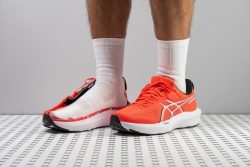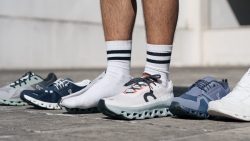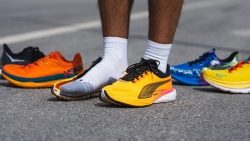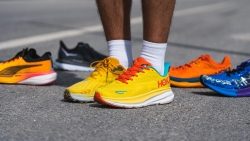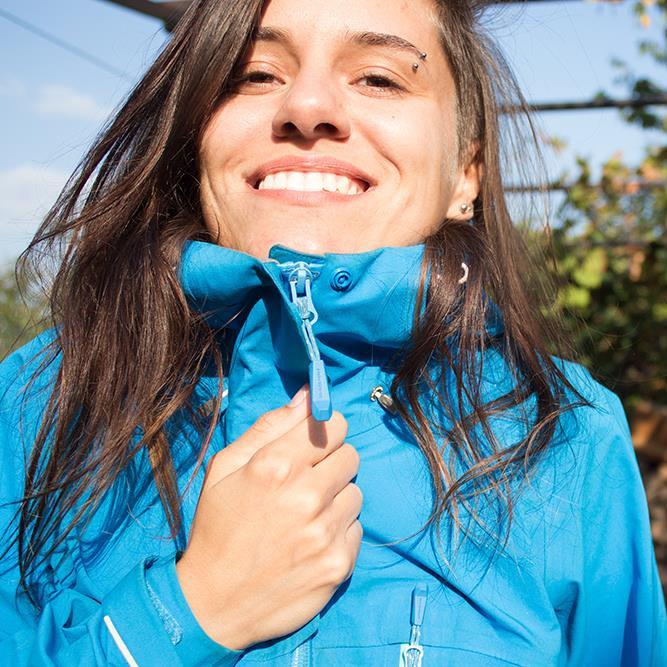7 Best Running Shoes For Flat Feet in 2025
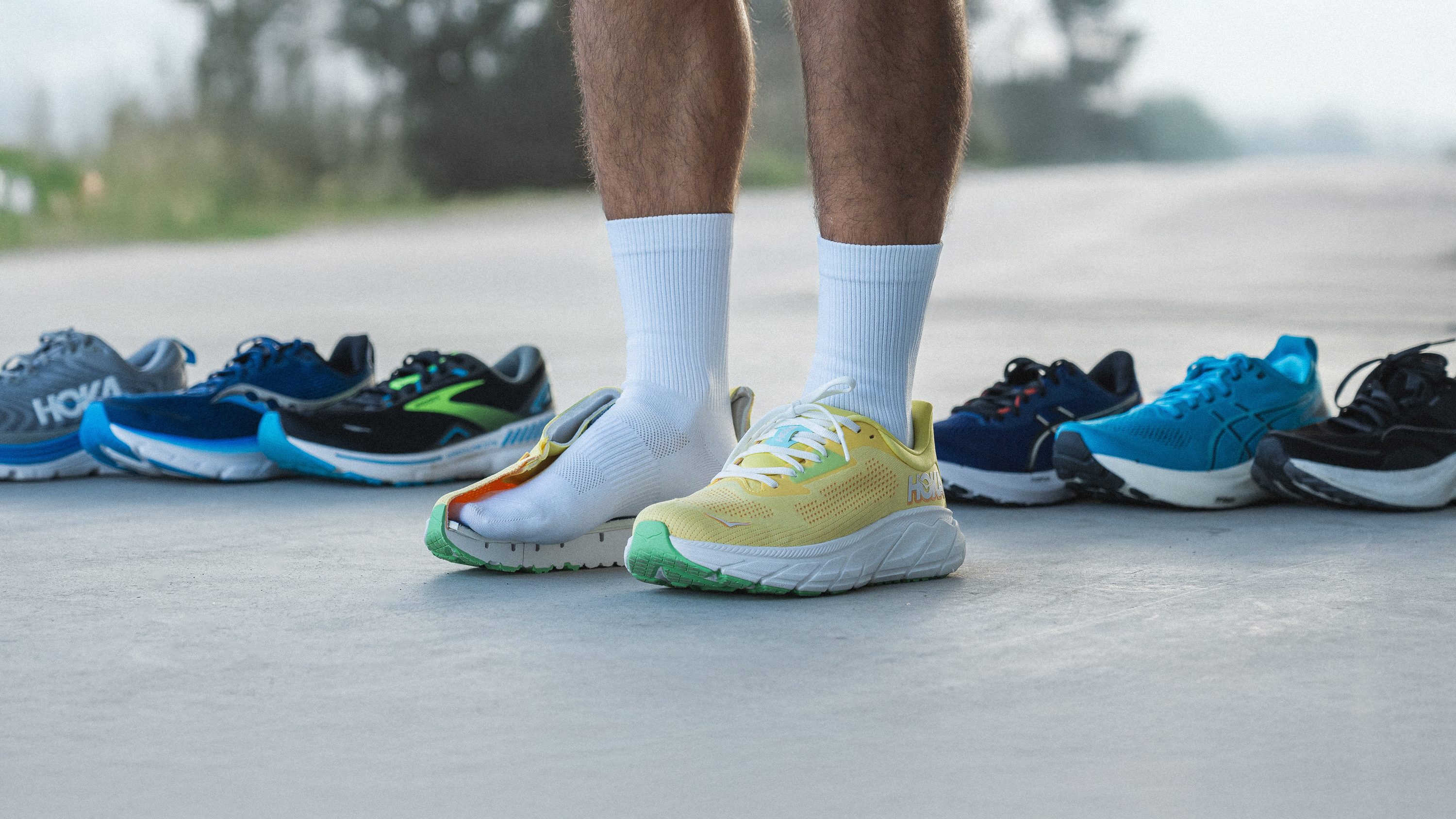
We buy shoes ourselves. We earn commissions when you buy through us, at no extra cost. Why trust us
Feeling comfortably supported becomes a priority when you have flat feet. We want to make sure that every flat-footed runner receives the right kind of support from their next pair of shoes.
Equipped with a shoe testing lab and a team of dedicated testers, we have reviewed running shoes that are recommended for flat feet.
Depending on what you value the most, we have selected our top picks in several categories. Whether you want more cushioning, extra space for the toes, or a more budget-friendly option, we found a shoe for every demand.
How we test running shoes for flat feet
- All shoes are purchased with our own funds to help us stay transparent and honest.
- We run in each pair before submitting our feedback. We ensure that the flat footers among us - both with flexible and rigid flat feet - lead the wear testing to prioritize their requirements and discuss their real observations about these running shoes.
- We slice these running shoes up in our lab to measure every imaginable parameter. Moreover, we set our gathered data side by side with the average values to have a qualitative analysis of each element of the shoes.
Best running shoes for flat feet overall
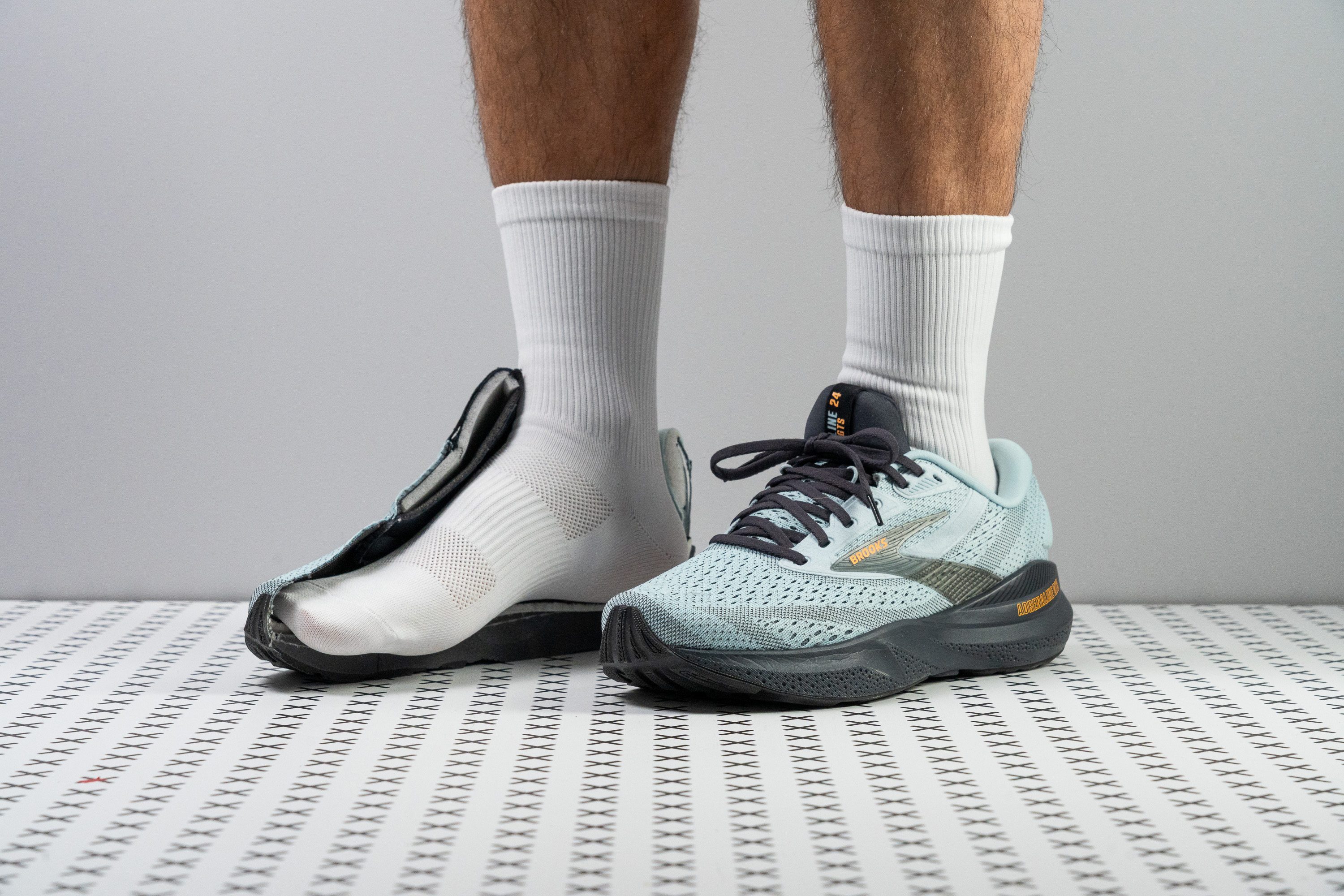
















































What makes it the best?
The Brooks Adrenaline GTS 24 is a solid recommendation for those needing stability because of its GuideRails technology and firm base offering a surefooted and centered ride. What makes this shoe stand out in the lab is its cushioned and flexible midsole that boosts comfort, offering reliable support without the usual rigidity of stability shoes. Therefore, it’s our top running shoe for flat feet.
The GuideRails technology extends along both sides of the shoe to raise the midsole sidewalls and create a secure fit. It prevents excessive pronation and spillovers because our feet are contained within the shoe. Besides this, we found a medial post that prevents our arches from collapsing.
The midsole offers a nice springy and firm sensation, which our durometer confirms with a 25.1 HA rating. This helps avoid foam collapsing and boosts stability. In terms of comfort, we measured the heel stack to be a massive 39.0 mm, cushioning each rear landing we make.
Comfort is also enhanced with its flexible midsole because it moves easily with our feet. Our bend test shows it’s 19.9% more adaptive than the average shoe, making it suitable for prolonged wear.
However, it features a steep 13.5 mm drop that will only work for heel strikers. Otherwise, it’s best to find a less aggressive incline.
Pros
- Stack height upgrade!
- Reliable support
- Breathable mesh with oversized vents
- Price remains unchanged
- Available in 4 width options
- Good durability
- Plush tongue for top comfort
- Ideal for heel strikers
- Foam upgrade to DNA Loft v3
Cons
- Firmer-than-expected midsole
- High drop may feel too steep
- Toebox height is a bit low
- Non-gusseted tongue
Running shoes for flat feet with the best shock absorption
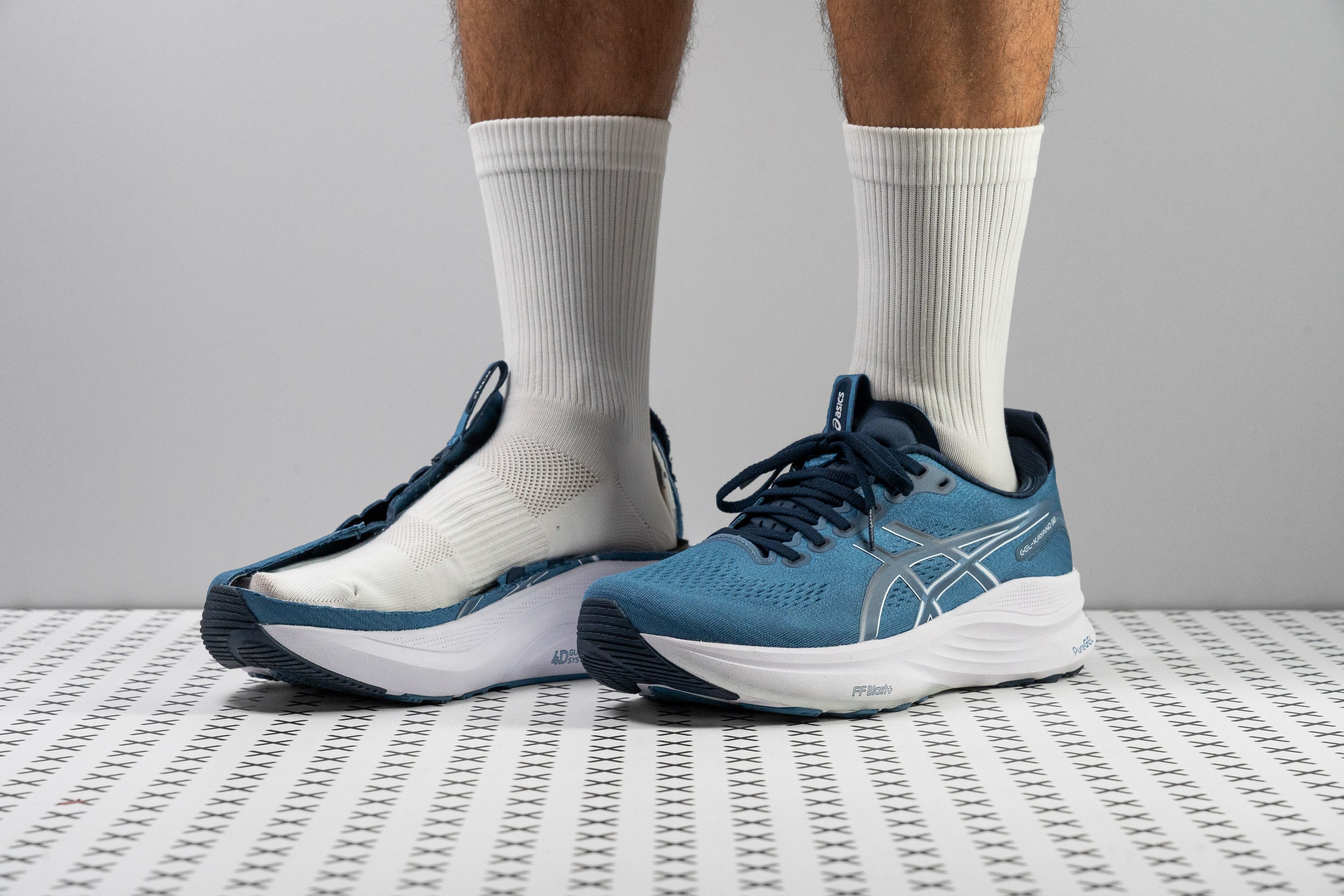













































What makes it the best?
Gel Kayano 32 ensures a smooth, luxurious, and steady ride. Boasting a plush and protective mega-stack and a 4D Guidance System, it redefines the traditional stability shoe with its highly cushioned feel, and our feet immediately felt this during our first strides. Our lab results support this maximalist as our pick for the best shock absorption for flat feet.
Upon initial slip-on, the midsole instantly feels like home. With a towering stack of 39.9/30.6 mm, each landing feels exceptionally protected from impact. Testing for its shock absorption, we proved its leg-saving nature with a high 133 SA and 116 SA in the heel and forefoot, respectively.
While most max-cushioned shoes are wobbly, GK32 defies the standard with its 4D Guidance System, which adapts to our foot shape to support the arch. Along with midsole sidewalls and an expansive base, each stride feels secure. Our caliper proves SUV-like measurements of 119.8/97.2 mm.
All the extra padding added extra weight. While the average running shoe is only 9.3 oz (265g), Gel Kayano 32 weighs 10.4 oz (295g).
Pros
- Amazing shock absorption
- Plush and breathable upper
- Made to last
- Dependable for most pronators
- Heavy-duty outsole with excellent grip
- Stable as a table
- Pillow-soft heel padding
- Improved fit
- Excellent build quality
Cons
- Not for soft-foam lovers
- Bad energy return
- Overpriced in Europe
Best daily running shoes for flat feet
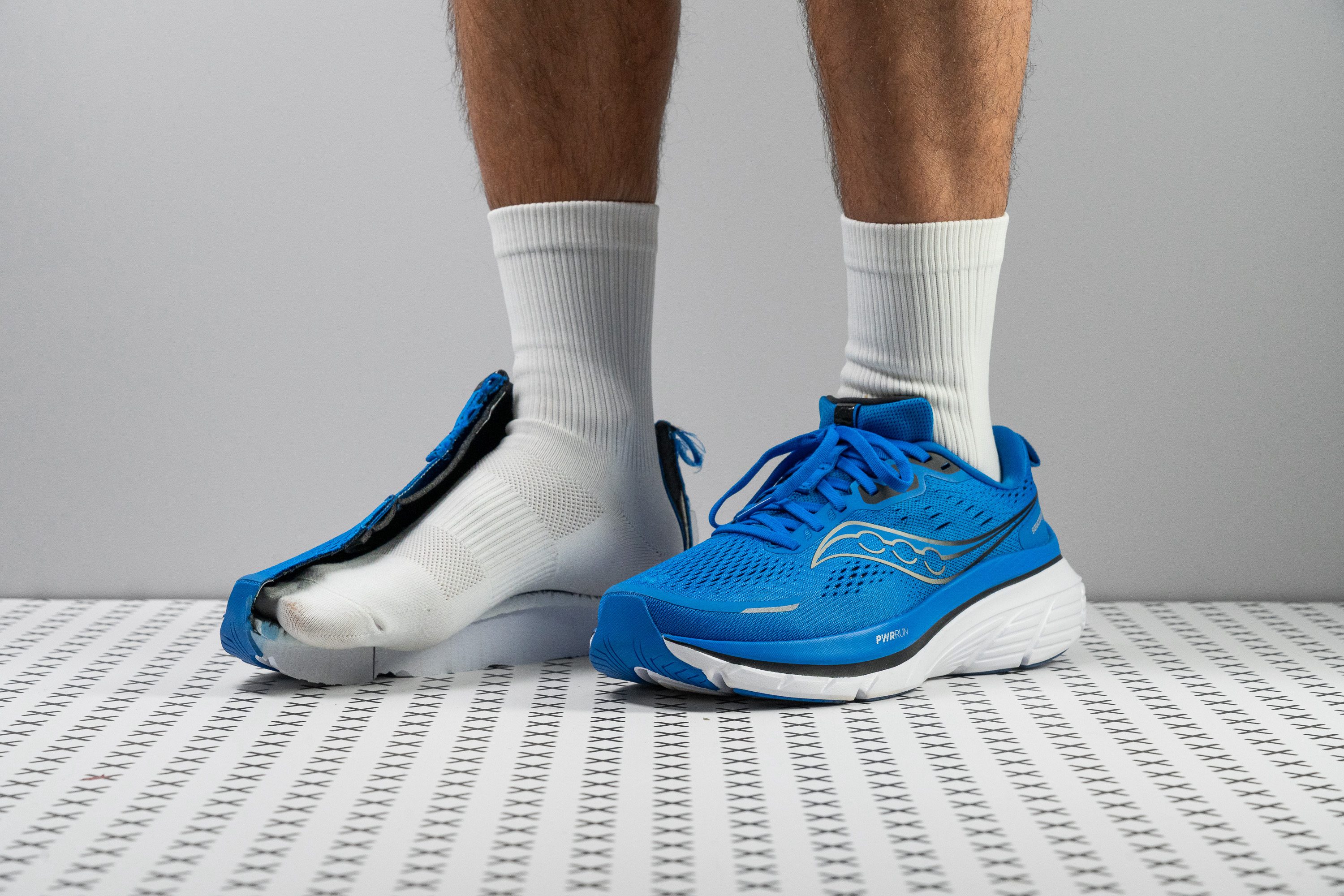















































What makes it the best?
Our daily runs reached new heights in the Saucony Guide 18. The underfoot sensation is comfy and composed, enveloping us in a gentle yet supportive embrace to promote steady strides, perfect for flat feet. Moreover, our lab confirms it's impressively lightweight, considering the level of stability it provides through its broad base.
A light and loose midsole grabbed our attention from the first step, confidently flowing against the typical rigidity of supportive shoes. Our bend test shows it’s 8.9% more adaptive than average. Furthermore, it's a breeze to wear with its light 9.8 oz (278g) build, effortlessly surpassing the 10.1 oz (286g) average stability shoe.
Remarkably, it maintains a substantial midsole without adding weight; boasting an impressive 36.0/27.7 mm stack. Furthermore, the midsole delivers a balanced ride, confirmed by our durometer with a 22.3 HA reading, providing a healthy mix of arch support and comfort.
An added appeal for flat-footers is its rocker geometry that promotes forward momentum, midsole walls that guide us in place, and a wide landing base that assures safe landings. Our caliper reveals it's 121.9/105.0 mm wide in the forefoot and heel, making it highly stable to any footstrike.
It’s not all sunshine and rainbows with the Guide 18. Its midsole feels uninspiring, which may disappoint runners seeking a lively ride.
Pros
- Upper now has exceptional breathability
- Stable yet non-restrictive ride
- Cushioned enough for long runs
- Handles walking too
- Impressively wide platform
- PWRRUN PB insole
- Secure and comfortable lockdown
- Excellent heel rocker design
Cons
- Too much exposed foam on outsole
- Feels bulky and not agile
- Midsole runs a bit firm
Best lightweight running shoes for flat feet
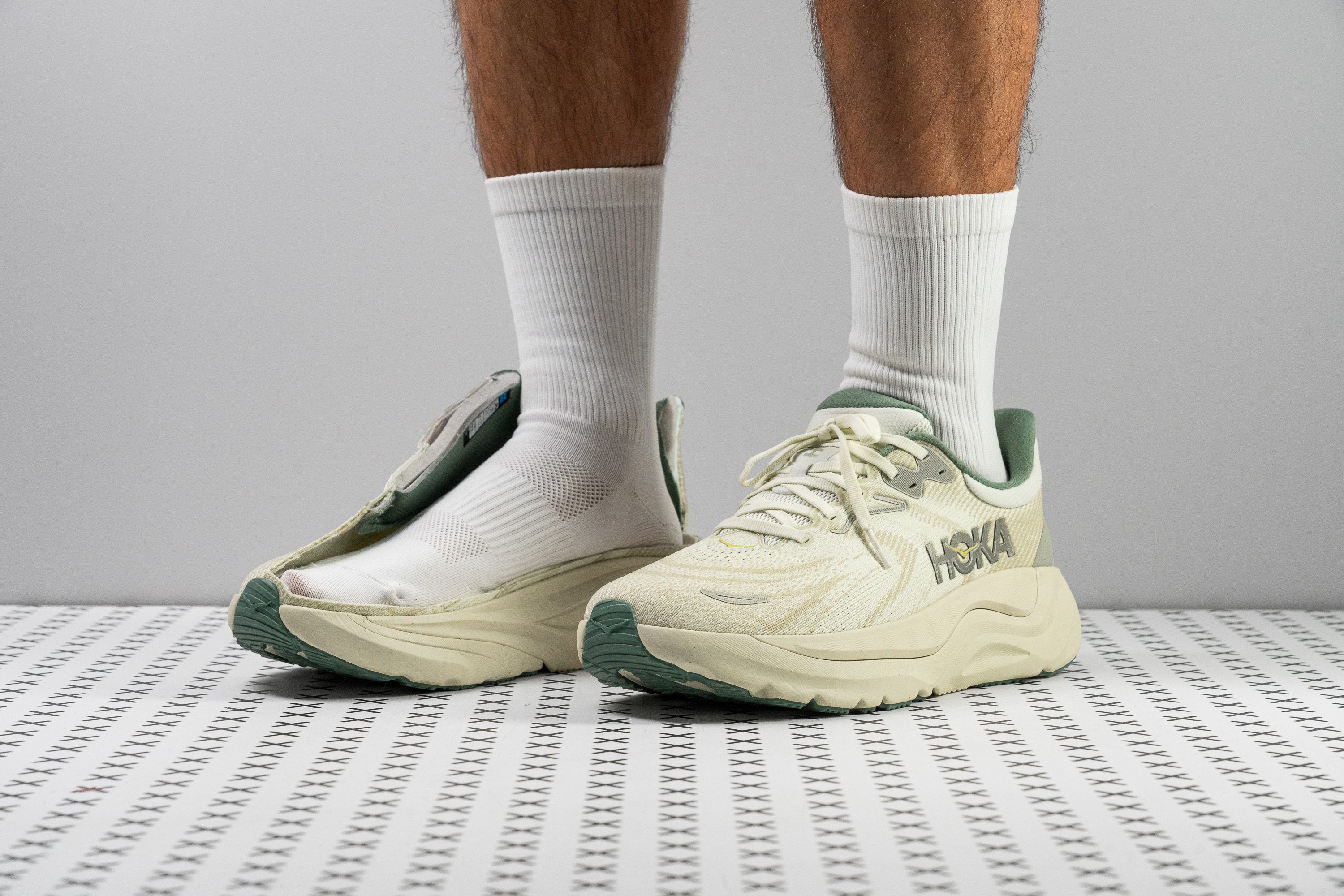











































What makes it the best?
We still can’t believe how Hoka Arahi 8 manages to deliver solid support and plush comfort in an airy package, and our lab test verifies its low figure, making it the best lightweight running shoe for flat feet. In our runs, we enjoyed solid footing and massive impact protection, allowing us to keep burning the miles effortlessly.
We immediately brought it to our scales and confirmed a low weight of 9.1 oz (259g), which is so impressive because it manages to stay below the 9.3 oz (265g) average neutral and stability running shoe!
Digging further in the lab, we discovered the H-Frame as Arahi 8’s main pillar of support. It’s composed of firmer foam to contain excessive lateral forces and keep us in place. The shoe’s high 5/5 torsional rigidity also helps in keeping us surefooted.
Beneath our feet lies abundant cushioning, with caliper measurements of 39.4/28.1 mm. Decades ago, it would have been hard to imagine a maximalist being a stability shoe! Not only is the shoe tall, but it also feels incredibly plush, receiving top-level shock absorption scores of 138 SA (heel) and 113 SA (forefoot). Our joints had no complaints in this pair!
However, an issue we have is its limited ventilation. Note that the Arahi 8 only feels comfortable when the temperature drops.
Pros
- Impressively lightweight for its size
- Strong shock absorption
- Wider fit than previous versions
- Outstanding durability across upper and outsole
- Early-Stage Meta Rocker smooths transitions
- Higher drop suits better heel strikers
- Comfy and plush for everyday use
- H-Frame stability system
- Comfortable heel counter
Cons
- Very poor breathability
- Grip needs to improve
- Still no supercritical foam
- Minor price bump
Running shoes for flat feet with the best energy return
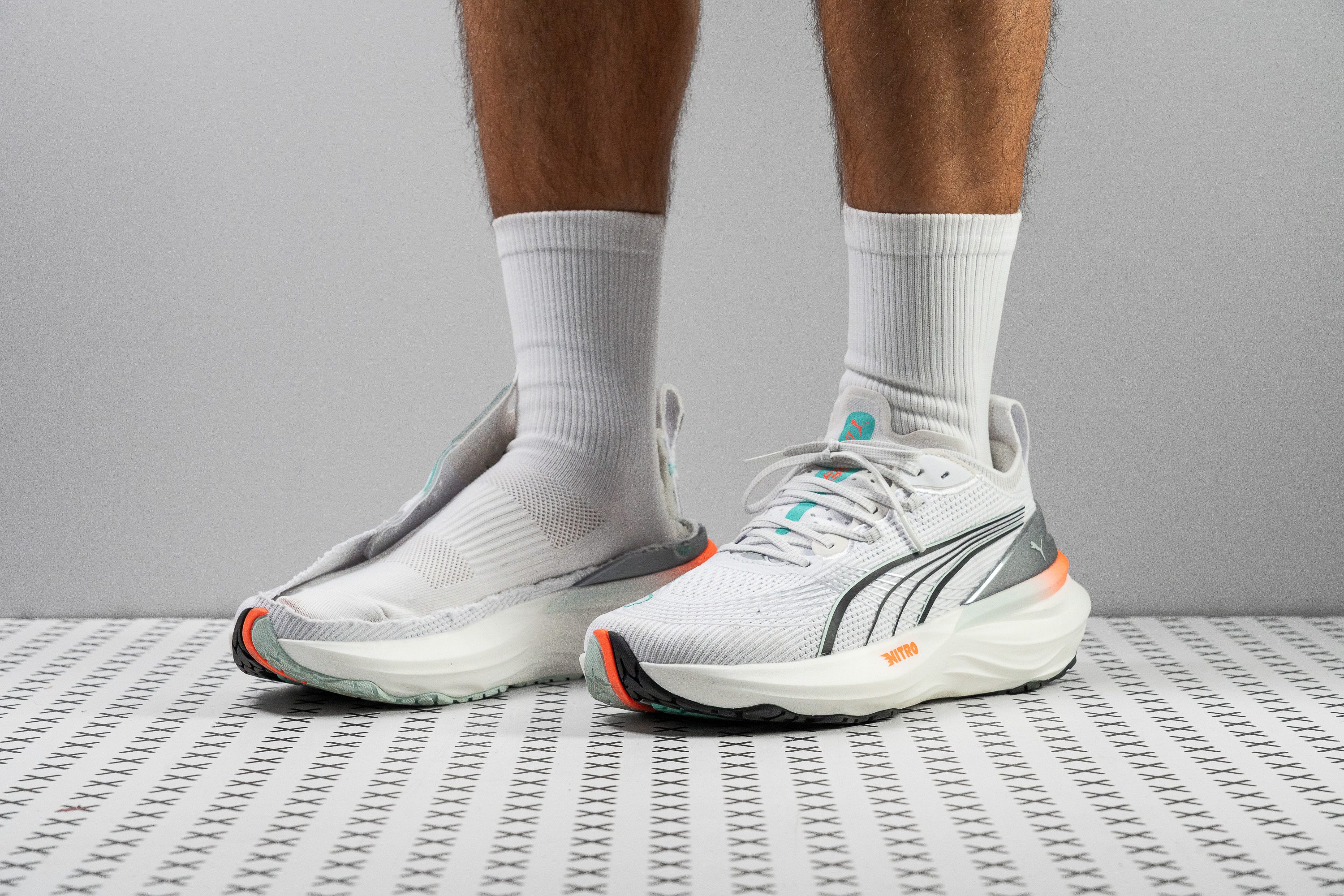











































What makes it the best?
The PUMA ForeverRun Nitro 2 cleverly finds a solution to address stability needs without losing its exciting ride. In our lab tests, it actually emerges with the best energy return among flat-feet running shoes! It’s wrapped in a plush yet breathable knit upper as the icing on the cake.
The Nitro midsole elevates daily runs with its solid rebound. Testing for energy return, we recorded above-average scores of 60.5% in the heel and 63.6% in the forefoot, mirroring the responsiveness we enjoyed in our runs.
For our surefootedness, the shoe features a wide midsole with the Run Guide System in the heel. It includes a plastic insert that secures the rear area, guiding us forward and preventing lateral motions. Our caliper verifies the platform is indeed broad at 121.3/97.6 mm.
Topping it all off is a knit mesh that feels so comfortable on the foot. Thankfully, it has countless perforations that deliver pleasant airflow. In our smoke test, it received an impressive 4/5 breathability score, perfect for training across seasons.
This shoe features a moderate stack and won’t please runners seeking a max-cushioned ride. There are many other options with thicker cushioning and higher shock absorption.
Pros
- Breathable and comfortable knit upper
- Amazing traction with PumaGrip
- Fair price for its features
- Excellent stability
- Flexible build
- Good durability
- Well designed for heel strikers
- Extra-wide midsole for added support
- Good option for everyday life too
Cons
- Heavier than the previous version
- Rocker mainly benefits heel strikers
- Stability system could be a bit intrusive
- Not the best for wide feet
Best running shoes for wide and flat feet
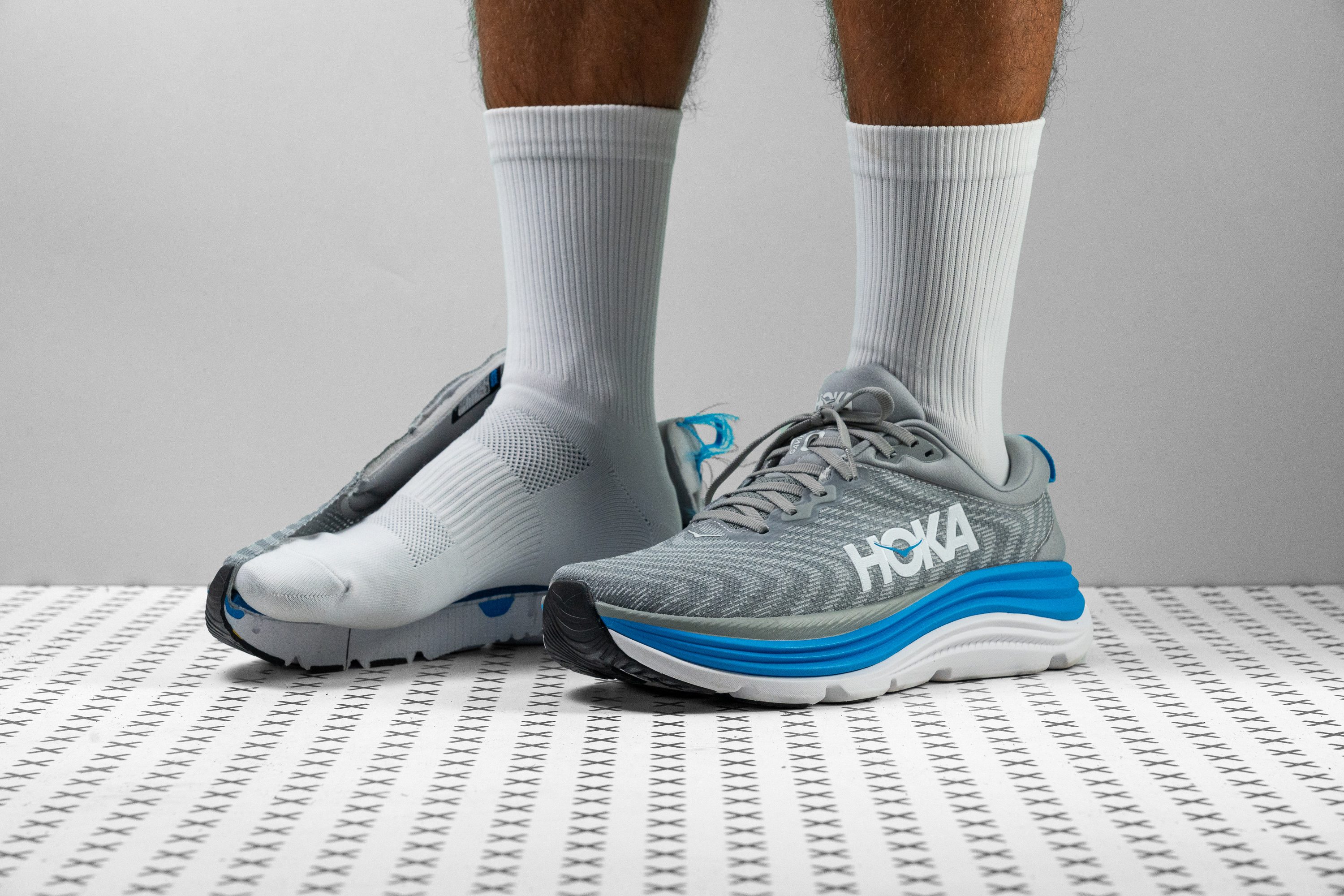
















































What makes it the best?
Gaviota 5 delivered steady support and luxurious comfort for any distance we ran through its stability features and relieving arch support. We discovered in our lab its clever combination of two foams, a breathable and non-restricting upper, and an extremely wide base—making it the best running shoe for flat and wide feet.
We could run endlessly with its ultra-soft 12.9 HA midsole (vs. 23.5 HA average) and higher-than-average stack. The plush cushioning erases ground impact and ultimately protects our legs from fatigue. Since softer foams tend to be wobbly, Hoka integrates a firmer 22.0 HA secondary foam in high-impact areas to ensure surefooted strides.
Further promoting stable landings is the extra, extra wide midsole. Our caliper measures 125.1/106.6 mm in the forefoot and heel, giving a mind-blowing 11.7/16.3 mm additional space to accommodate wide feet. With its H-Frame, Gaviota 5 shines in our lateral stability test and keeps us centered.
Even the upper gives a lot of freedom through its spacious toebox that allows our natural toe splay and the well-ventilated upper that allows air to flow liberally. It scored the highest 5/5 on our breathability test because the thin engineered mesh has many ventilation holes.
As expected from a cushioned stability shoe, it sits heavier at 10.6 oz (299g) vs. the average running shoe (9.4 oz / 266g).
Pros
- Remarkably stable
- Breathable and comfortable upper
- Lightweight for its size
- Good stability option for forefoot strikers
- Ideal for wide feet
- Excellent for long runs
Cons
- Low drop might pose issues for heel strikers
- Performs poorly in colder conditions
- Not for narrow feet
- Midsole feels flat
Best budget shoes for flat feet
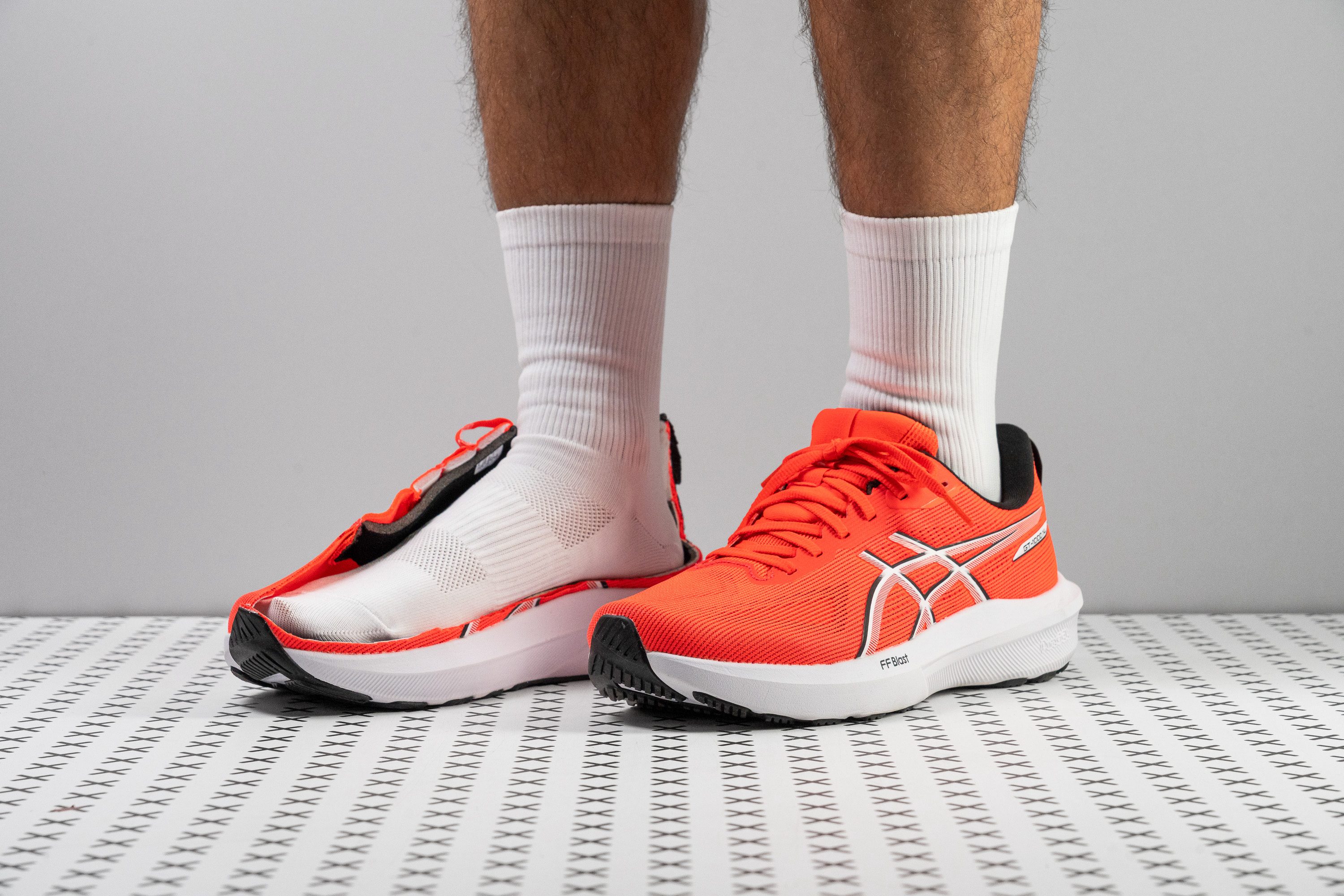













































What makes it the best?
Those of us with flat feet deeply enjoyed the steady and confident strides we had while running in the ASICS GT 1000 14. Its 3D Guidance System’s support, smooth and flexible ride, and long lifespan make its $110 value stand out vs. the $142 average stability shoe. Overall, it is our best budget pick in the flat-footed running category.
Diving deeper into the lab, we found the 3D Guidance System with a stiffer arch construction, a broad 94.8 mm heel, and high sidewalls that still allow our natural movement. The midsole resists ankle twists, proven by its 4/5 torsional rigidity rating in our manual assessment.
However, in terms of forward movement, it emerged 19.1% more flexible than average. The shoe is an ideal mix of comfort and support, proving its versatile and fluid nature.
The AHAR outsole proves its longevity by resisting our brutal Dremel, ending up with a minimal 0.7 mm dent vs. the 1.0 mm average. The cost per wear is truly worth it since the 4.5 mm thick rubber will definitely last longer.
Unfortunately, the price we have to pay for its value is low shock absorption. Those who crave a plush sensation underfoot should try more cushioned alternatives.
Pros
- Supercharged stability
- Ideal for heel strikers
- Still offers amazing value
- Fuss-free, durable design
- Improved outsole traction
- Comfortable for everyday wear
- Great step-in feel
- Improved foam from v13
Cons
- Bad breathability
- Still lacks energy return
- Boring ride
As always, if you’re experiencing any discomfort or pain, we wholeheartedly recommend visiting a specialist like a PT, podiatrist, or biomechanic specialist. Best to work with a specialist who works with runners.
Our guide here has an educational purpose.
2 types of flat feet: which one do you have?
Flat feet (also called fallen or low arches) are characterized by having no visible arch between the heel and the ball of the foot. It implies that the entire sole of the foot touches the ground when standing.
Based on studies, this foot condition affects 20% to 30% of the general population. For adults, it is more common among women who are over 40 years old and people who are obese.
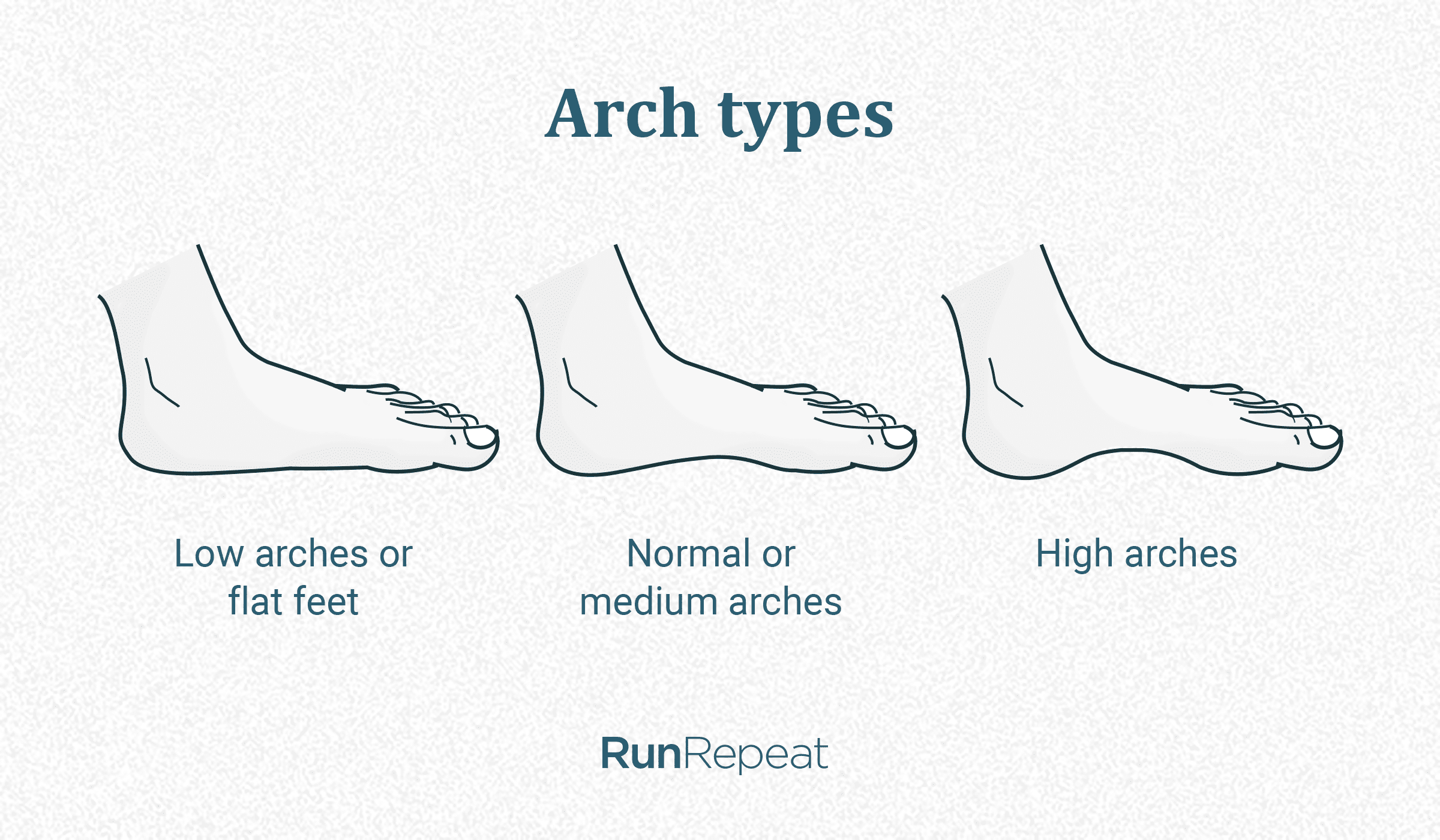
Here’s a rough overview of the differences between flexible and rigid flat feet:
| Flexible flat feet | Rigid flat feet |
| The arch is visible when there is no weight (ex. while sitting, on toes, or lying down); it disappears when weight is put on the legs. | Arch is not visible; remains flat in all positions. |
| Usually painless | Cause pain during everyday activities |
| Usually affect both feet | Usually affect one or both feet |
If you’re not sure about the type, you can do 2 tests:
- Tiptoe test: stand up and stand on your tiptoes. If your arches form, you have flexible flat feet.
- Jack’s test: have someone passively dorsiflex your big toe. If you have flexible flat feet, your arch will be noticeable.
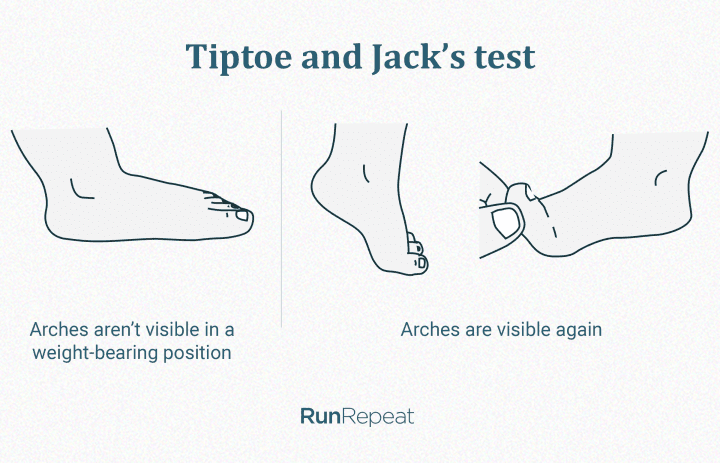
What type of shoes work best for flat feet
Runners with rigid flat feet need different levels of support than runners with flexible flat feet. It’s important to understand that, because not all flat feet are the same, not all runners will enjoy the same shoes.
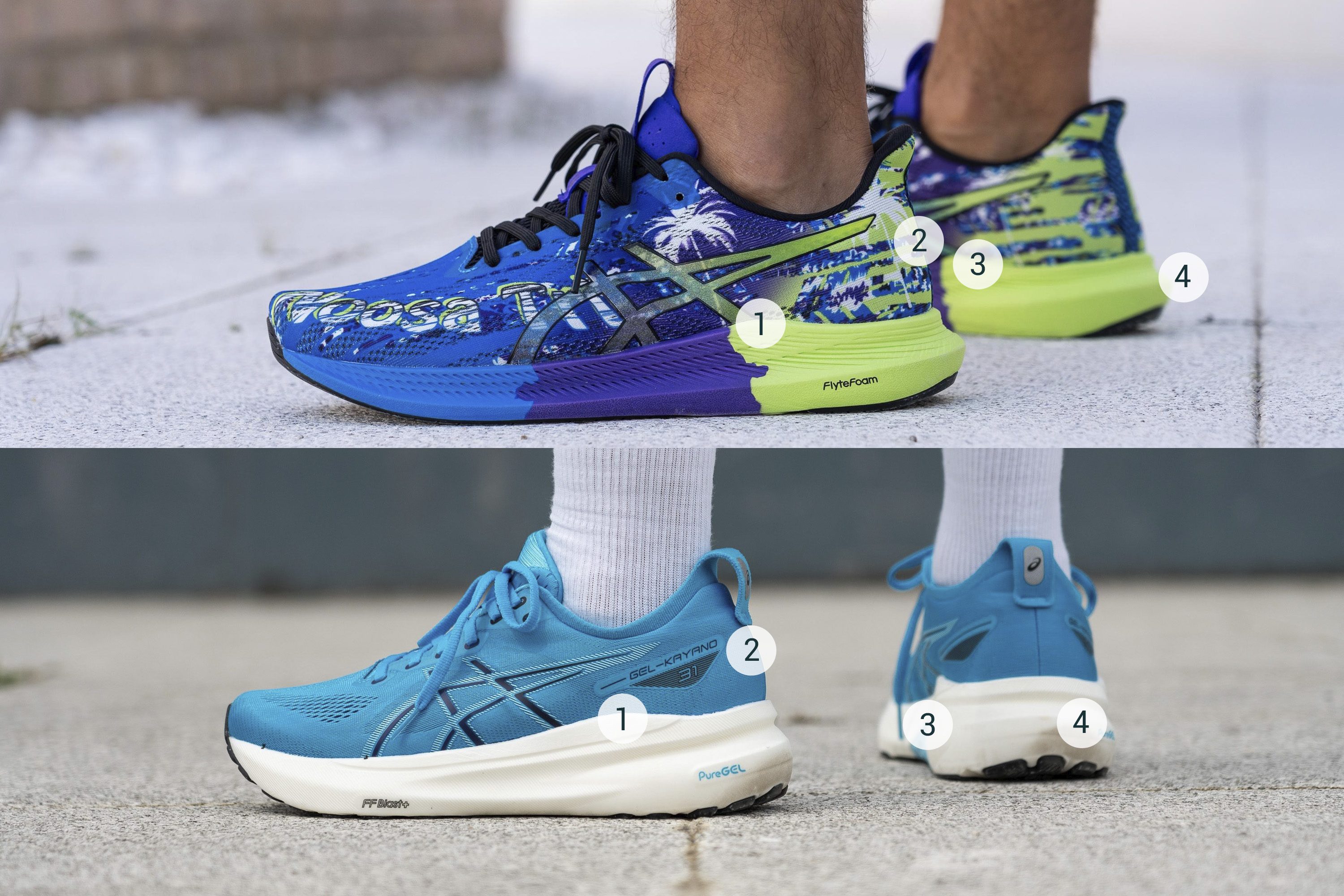
Most overpronate, so they enjoy stability shoes but have different preferences when it comes to stability technologies. Some runners with flat feet even enjoy running in neutral shoes because they don’t overpronate a lot.
Here, we will give overall guidelines on what usually works best for flat feet.
|
If the topic of arch supports interests you, we’ve covered it in great detail in our guide Arch Support for Runners: What, How and Why. And, if you want to learn everything about pronation, head over to our guide Pronation 101: Running Shoe Choices, DIY Analysis, Injuries. |
It’s also important to note that stability features are found in daily trainers. Shoes that are made for tempo runs and/or races rarely fall into the stability category because, at such a pace, runners need less stability because the ground contact time is significantly reduced.
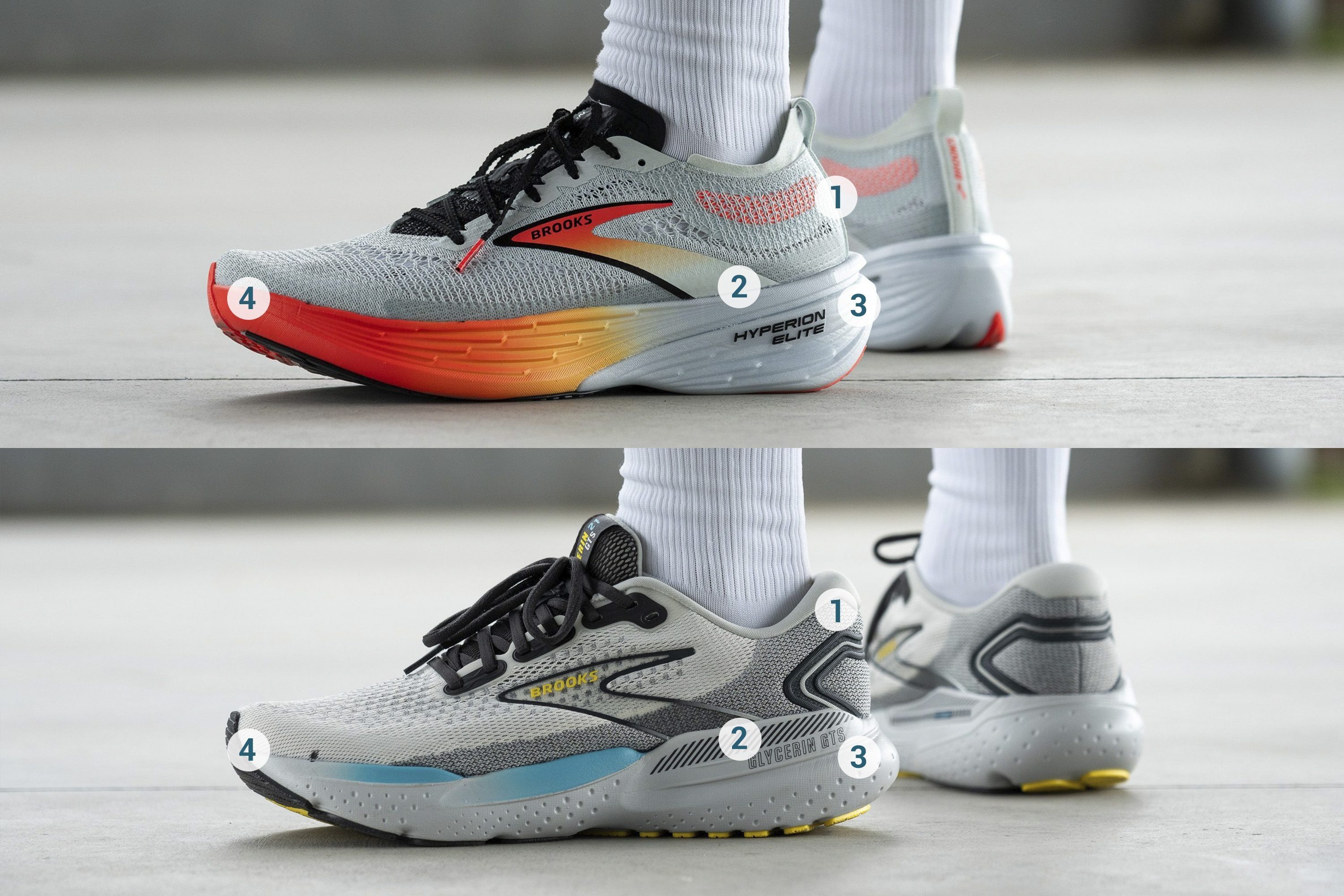
ALL shapes and forms of STABILITY
When it comes to stability, flat-footed runners need different levels of it and it comes in different forms. The lowest levels of stability are actually found in neutral shoes.
There are, however, stable neutral shoes that offer some stability: they usually have a wider and stiffer platform and some support on the upper, like stiff and padded heel counter or structural upper overlays.
| Stability (overpronation, flat feet) shoes | Stable neutral shoes |
| Only these shoes have trademarked stability technologies like GuideRails, GuideRail, J frame, H frame, 4D guidance system, etc. | No trademarked stability technologies. |
| Best for moderate overpronation. | Best for neutral pronation. |
| Usually stiffer than neutral shoes. | Usually more flexible and softer than stability shoes. |
|
Both of these can have a wider base, sole flares, stiff heel counters... Both can work for mild overpronation. |
|
In case you want to give these a try, we suggest looking for: firmer foams and wider and stiffer platforms!
Why neutral shoes might not work: too much instability under the midfoot results in no medial support or even discomfort. They make flat feet work harder instead of stabilizing them. A narrow platform, especially at the midfoot, adds another layer of discomfort.
9 stability features
Comfort is the obvious one and we hope that by now you know that. A shoe has to scream comfort! No hot spots, no rubbing, no obtrusive (painful) arch support.
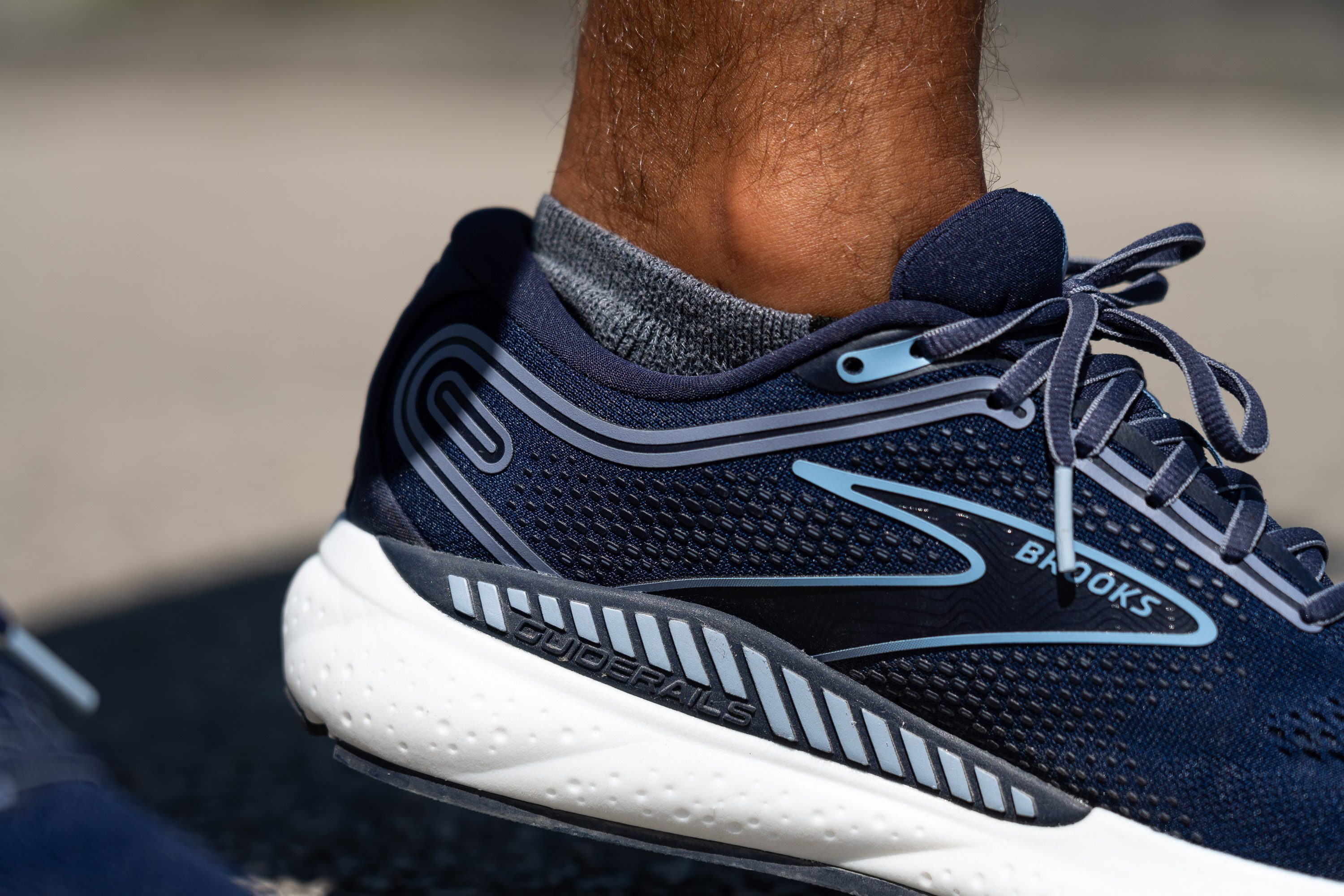
Here are stability features used in shoes for flat feet (they stabilize the ankle by preventing excessive inward rolling to a certain degree):
- Medial post (high level of stabilization)
- Dual density midsole (high level of stabilization)
- Stiff and padded heel counter
- Side walls (high level of stabilization)
- Heel bevels
- Sole flares
- Structural upper overlays
- Stiff base (high level of stabilization)
- Wide platform with maximal ground contact
We will explain all of these features below. Some of these are often found in neutral shoes, especially stable neutral shoes.
Most shoes combine more than 1 stability feature. Some combinations are even trademarked, like 3D and 4D Guidance system from Asics.
Runners have to try the shoes on and see what works for them. For some, a medial post is obtrusive, for others it’s necessary. Some enjoy a very stiff base and a stiff heel counter, while others prefer some flexibility. While GuideRails stabilize the flat feet of some runners, in other cases, it’s the dual-density midsole that does the magic.
Medial post in shoes for flat feet
Medial post is a piece of plastic or firmer foam and, as the name suggests, it’s located on the medial (inner) side of the shoe. Here, it is able to prevent the ankle from excessive inward rolling and collapsing of the arch (to some degree). It can be placed just under the arch or it can be longer and look like a frame.
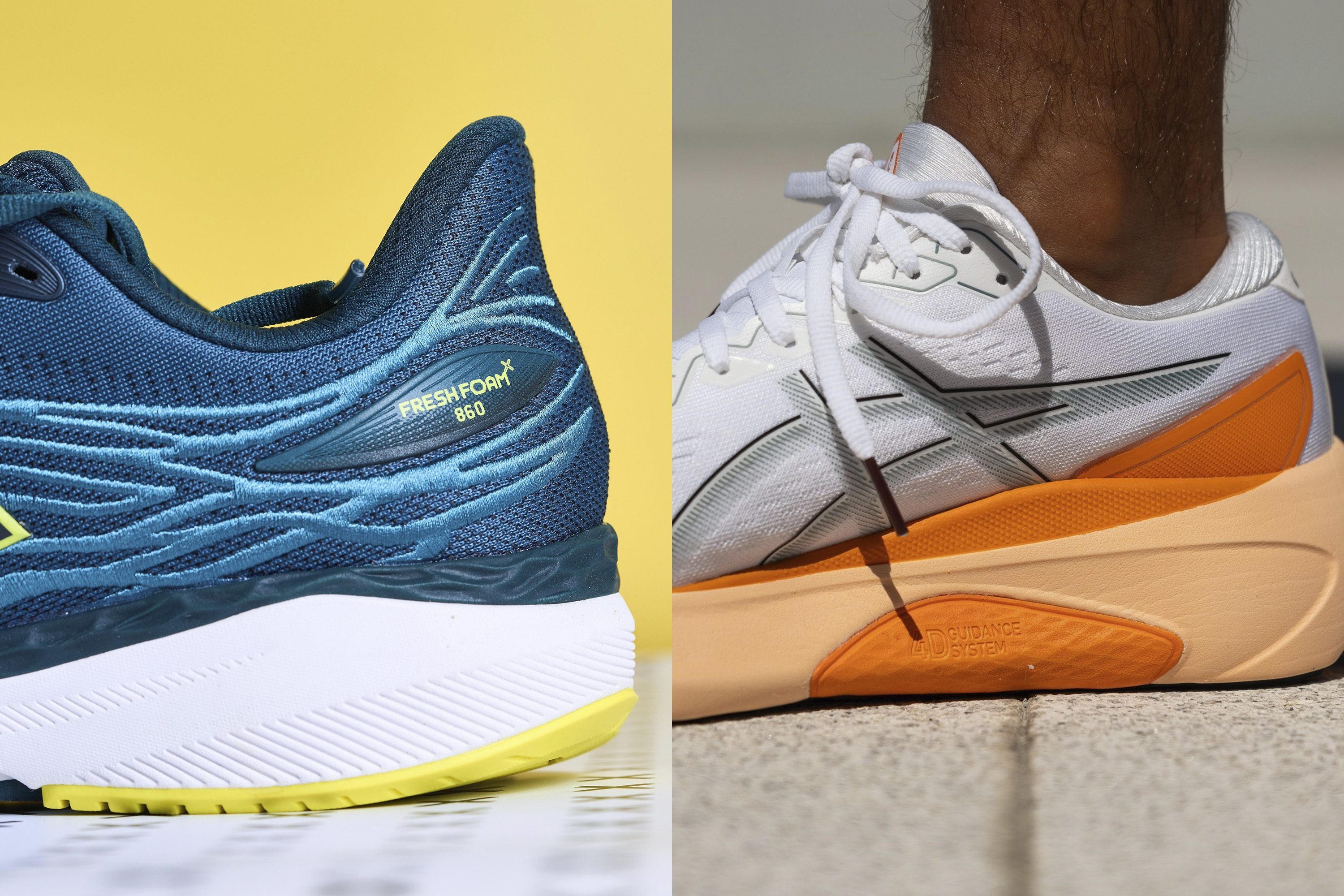
Why a medial post might not work: Some medial posts can simply be too firm which results in discomfort as they push into the arch harshly.
Dual-density midsole in running shoes for flat feet
These midsoles are, as the name suggests, made of 2 foams of different densities. A firmer one is usually placed where extra support is needed: under the arch, on the inner side at the forefoot, and/or at the outer side at the heel.
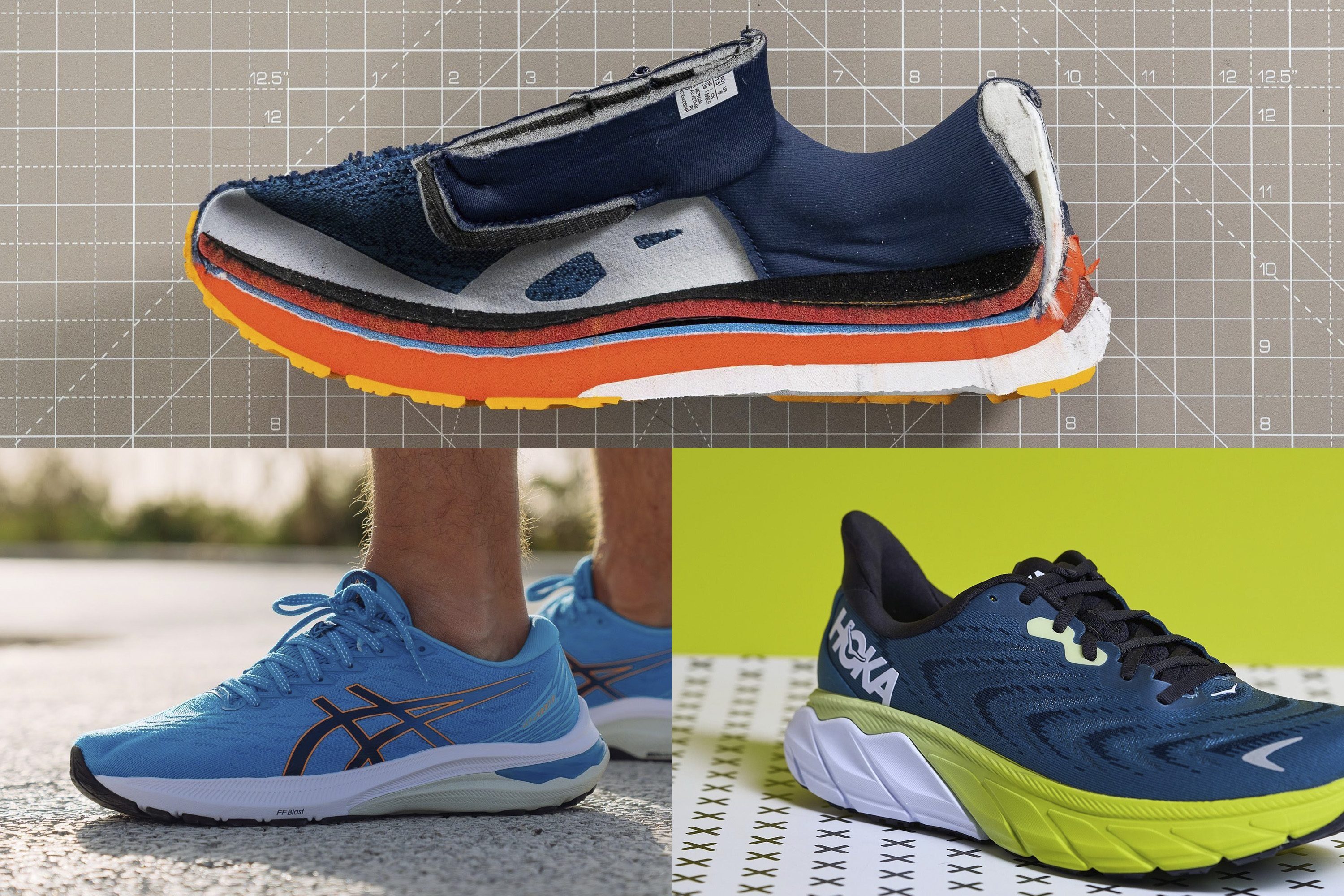
Some brands have trademarked their designs so we have H-frame and J-frame found in Hoka shoes.
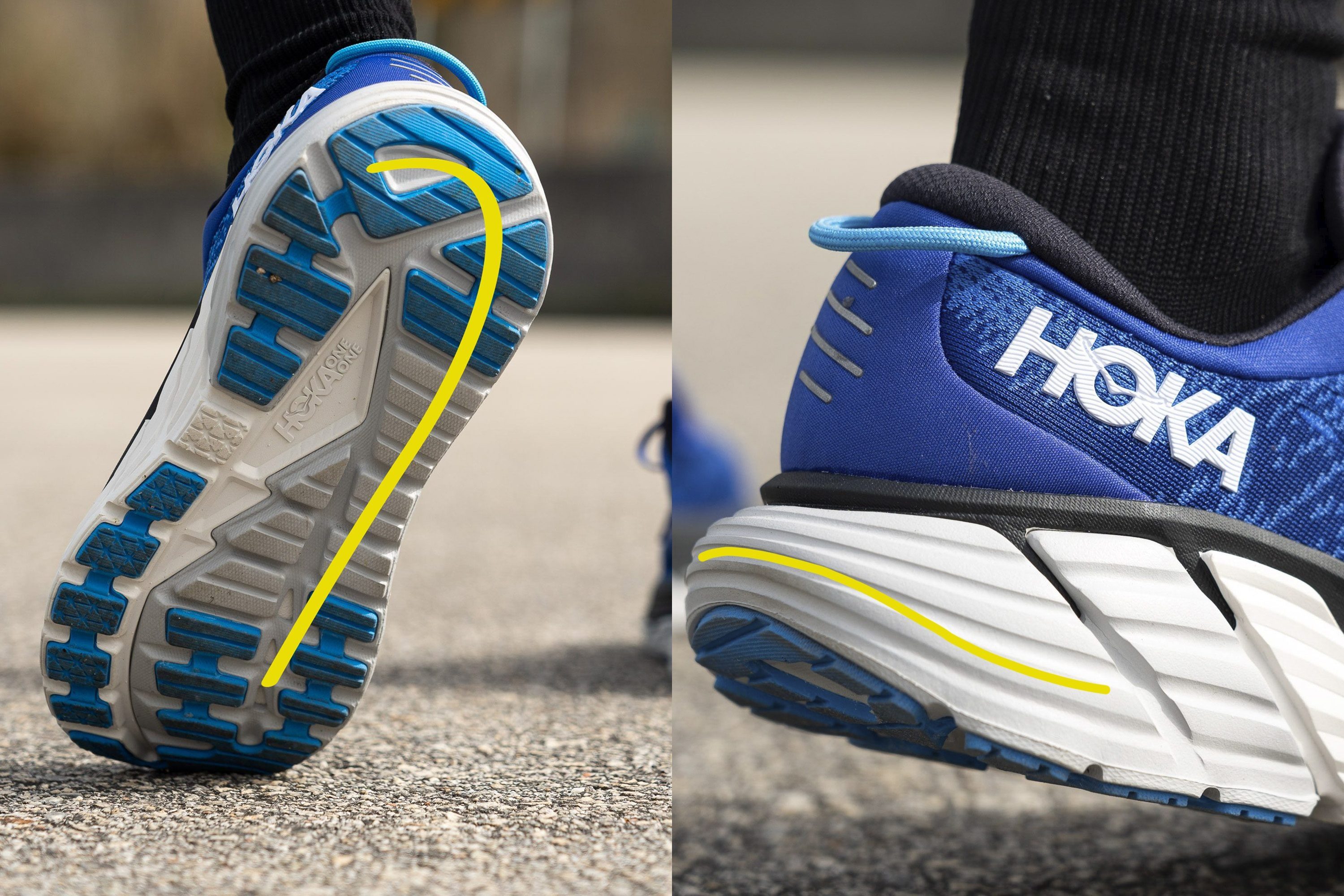
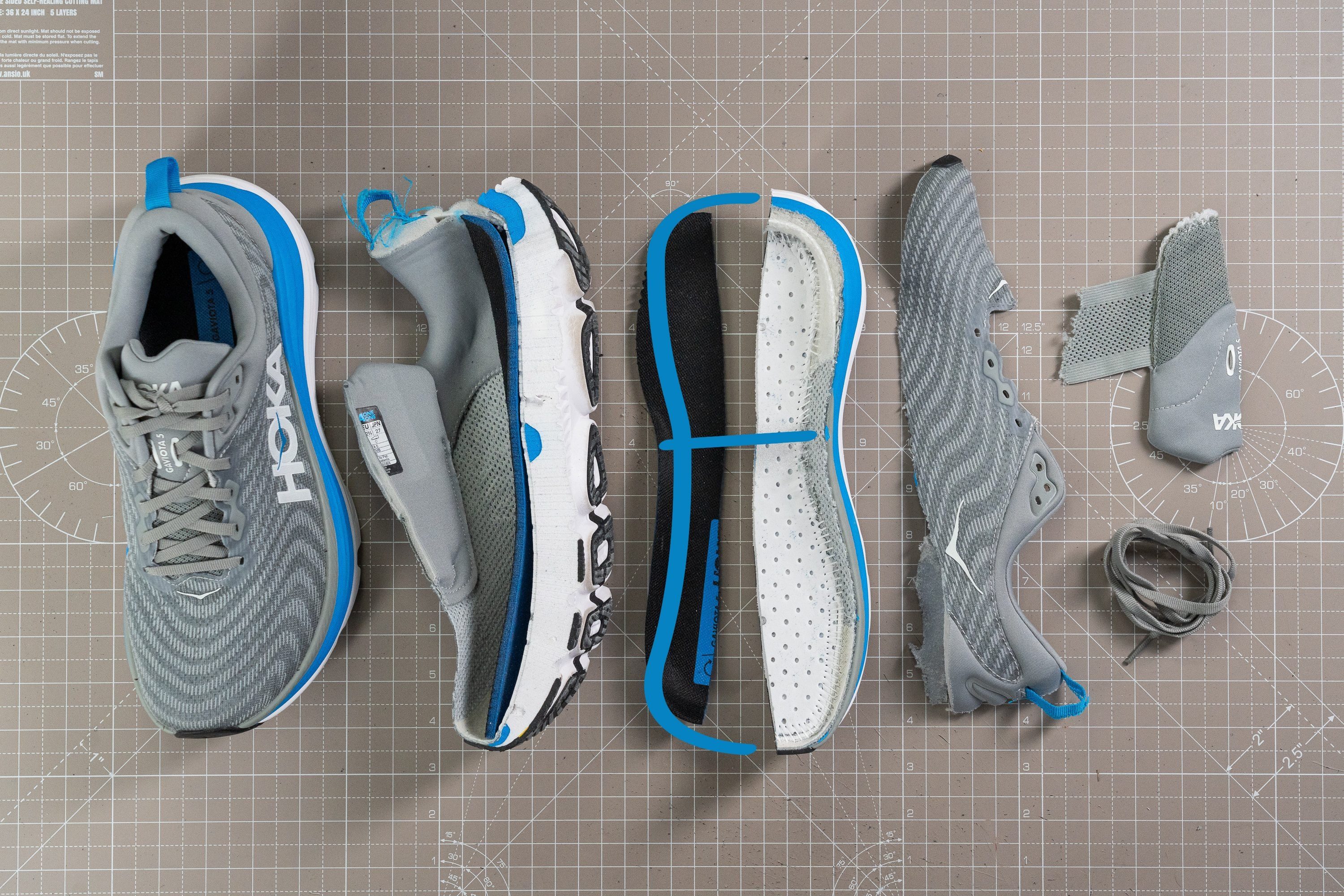
We always measure the softness of the midsole and, when it's a dual-density one, we take both measurements.
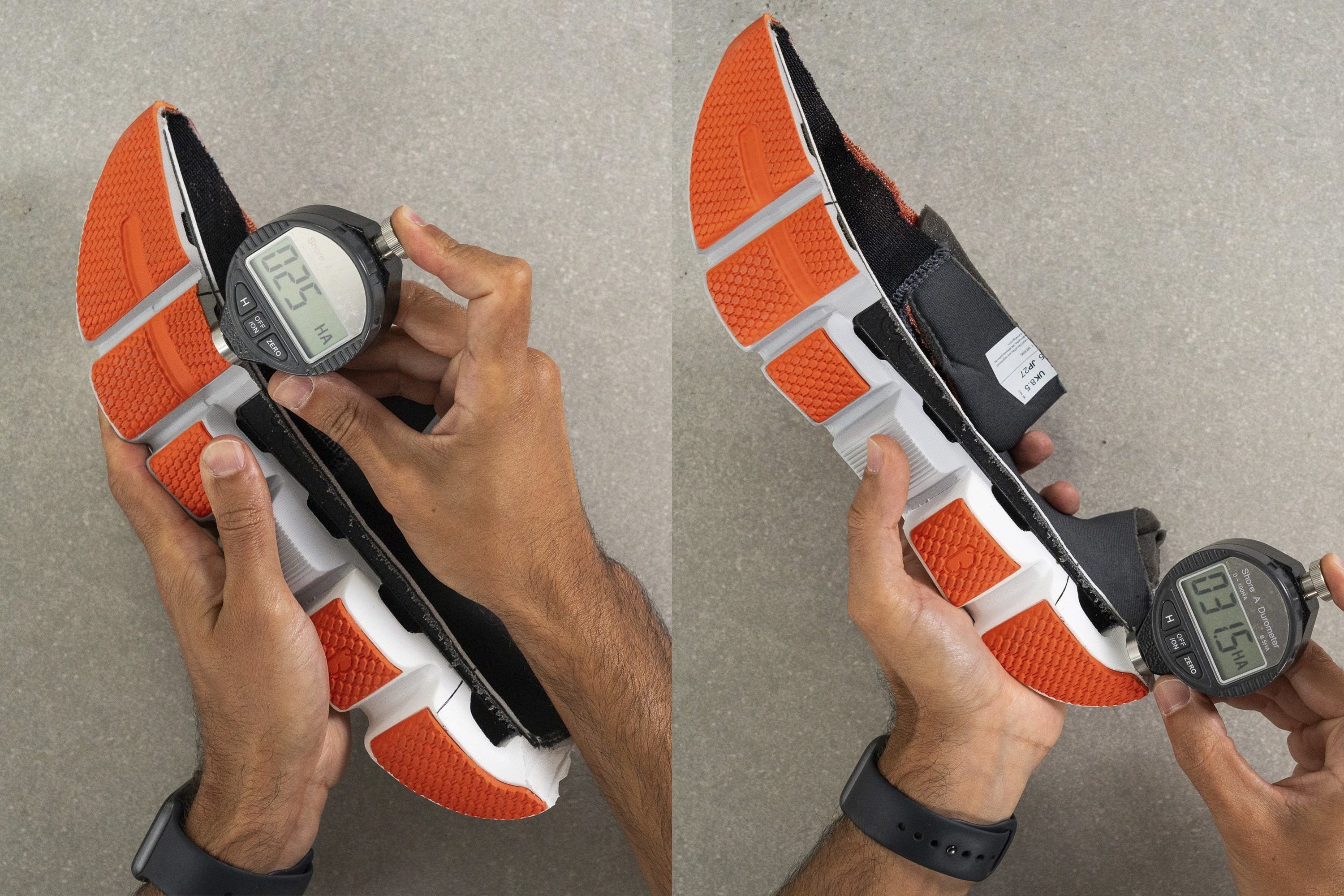
Because many of the best-rated running shoes for flat feet are soft, here are firmest picks in case you're looking for a firm ride:
Shock absorption of running shoes for flat feet
When talking about stability, we often focus on the softness of the midsole, because that extra firmness that's usually part in the secondary foam or medial posts, is what makes the feet more stable. However, softness is only one part of the story and, to understand how midsoles work and how running shoes feel, we can not skip shock absorption.
Shock absorption is the midsole's capability to dampen the impact at the landing. Ideally, it's higher rather than lower because when it's bad, it means our feet have to work more (to deal with extra stress that's sent to our muscles, tendons, and joints).
However, even if the midsole is able to reduce the impact forces, what if it compresses and then barely gets back up? What if it bottoms out and makes our feet work more? To cover that angle as well, we measure energy return. This number tells us how effectively the foam can bounce back after being squished at the landing. Higher energy return means less fatigue, so we want it to be high.
Keep in mind, though, that the highest energy return is usually found in competition running shoes, so running shoes for flat feet can't be at the top, given that stability features aren't prioritized in race shoes. We almost always find them in daily trainers.
Side walls bring a lot of stability for flat-footed runners
These walls are actually midsoles that are extended upward to create “walls” that keep the foot more locked in.
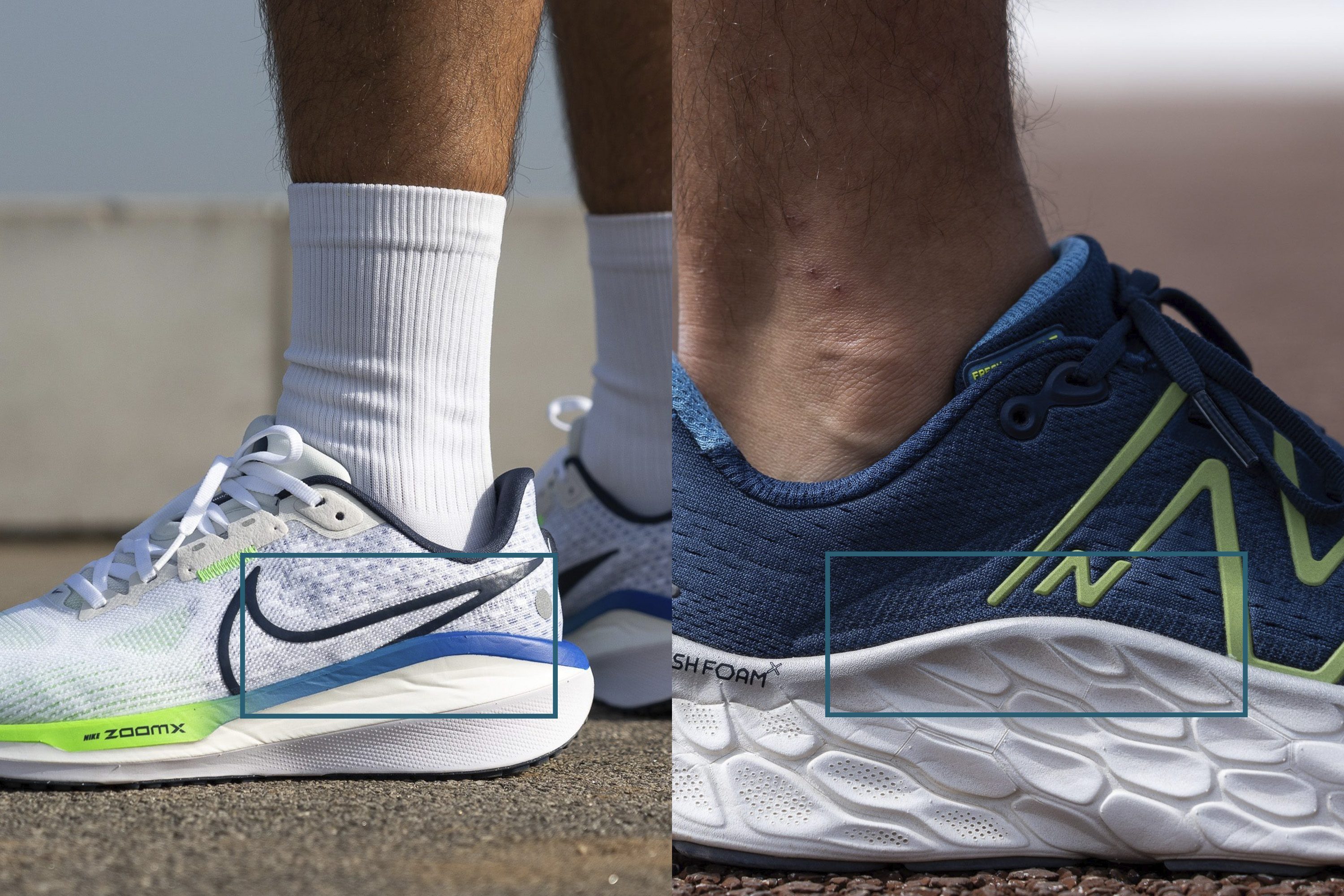
Again, some brands have trademarked their technologies that look a lot like the side walls above.
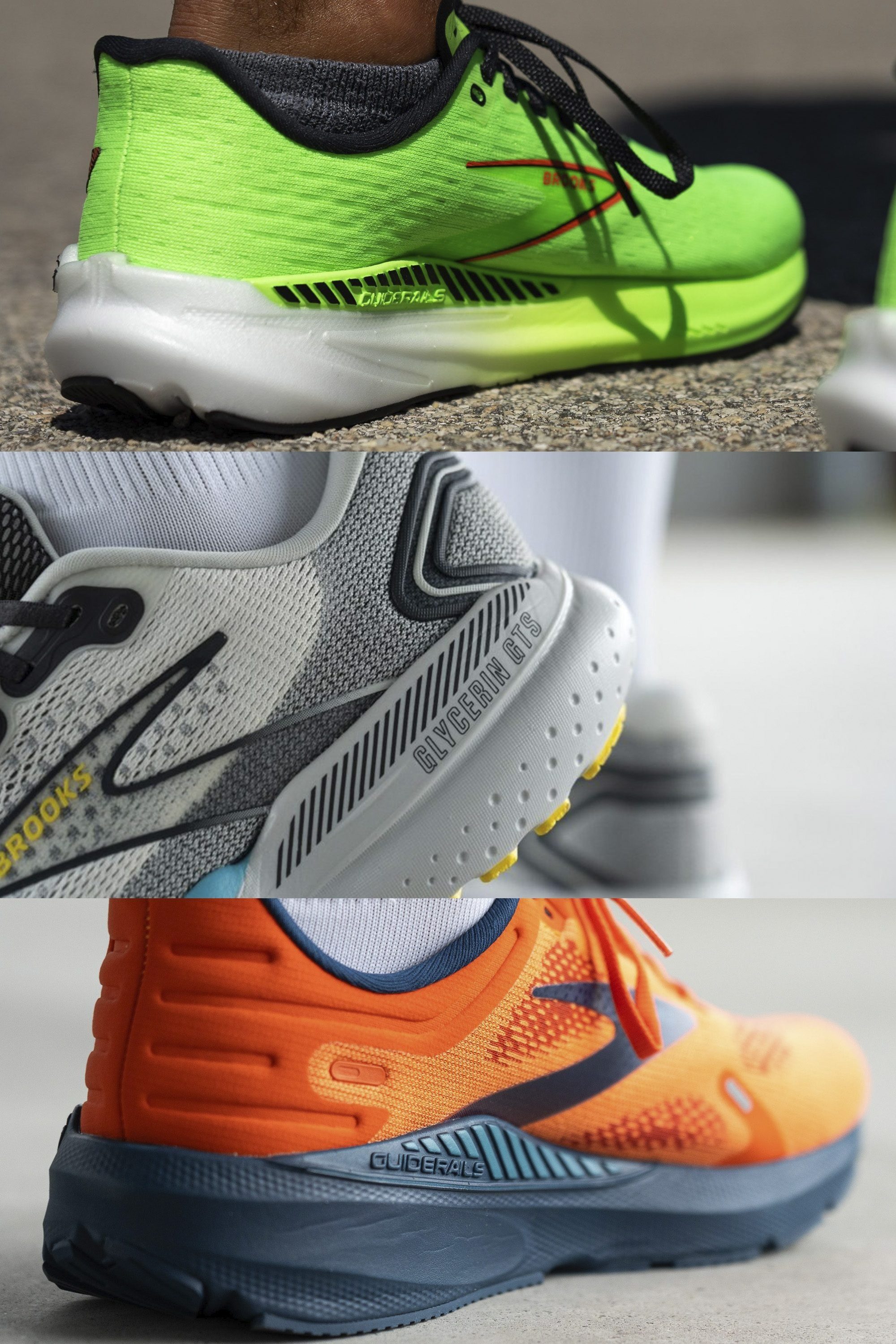
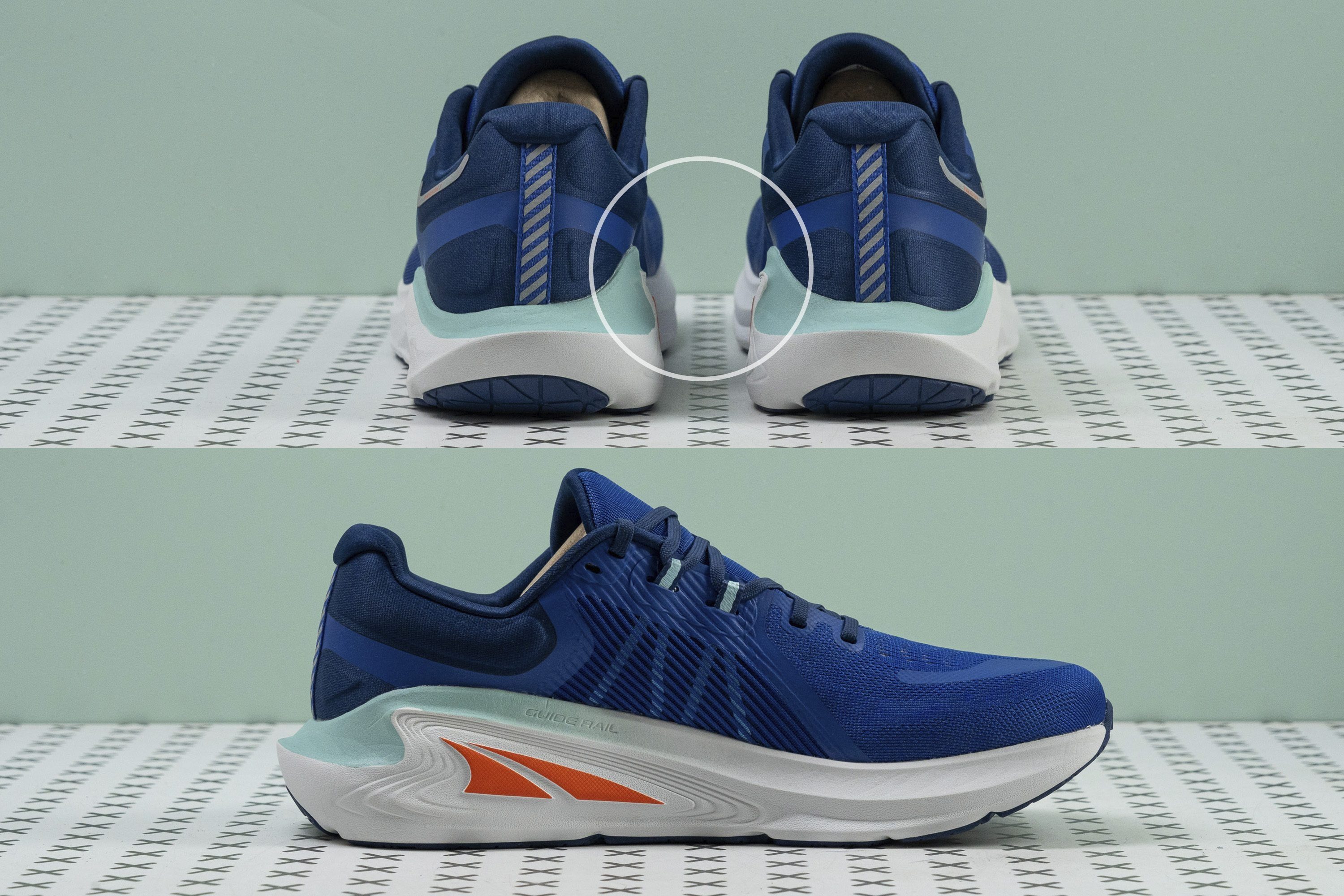
These sidewalls found on the medial (inner) side in Altra shoes are trademarked as Guide rail
Heel counters: stiff and padded usually work best
Stiff heel counters lock the heel in place and help stabilize the foot. When they work, they work wonders because of that stability and because they are padded - less room for any unwanted movement, plus more comfort.
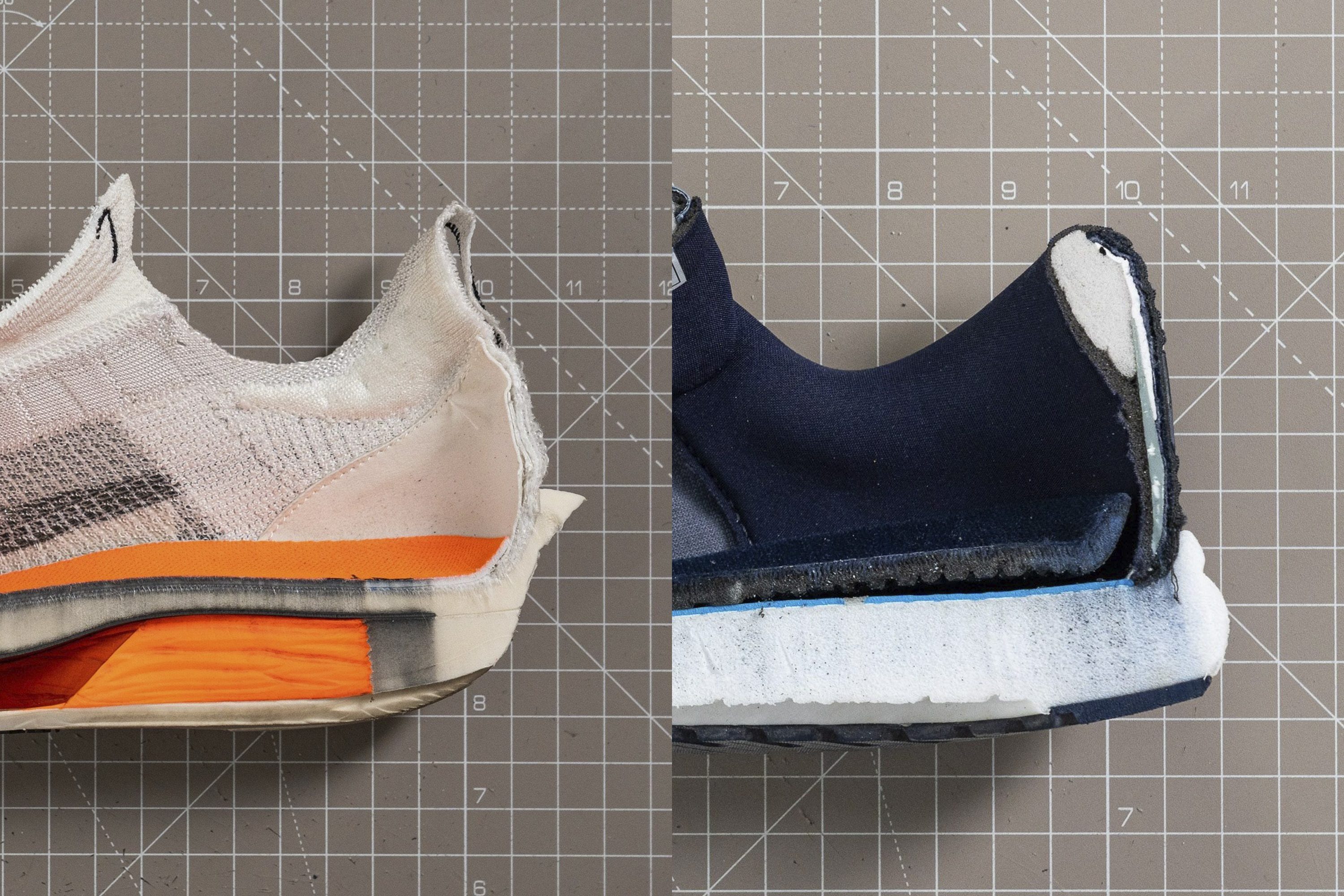
Why stiff heel counter might not work: it does not match the shape of your heel so you experience weird heel slippage or pain.
The stiffness at the heel can come from external heel counters and internal ones. Internal one was shown above, and here are examples of external heel counters.
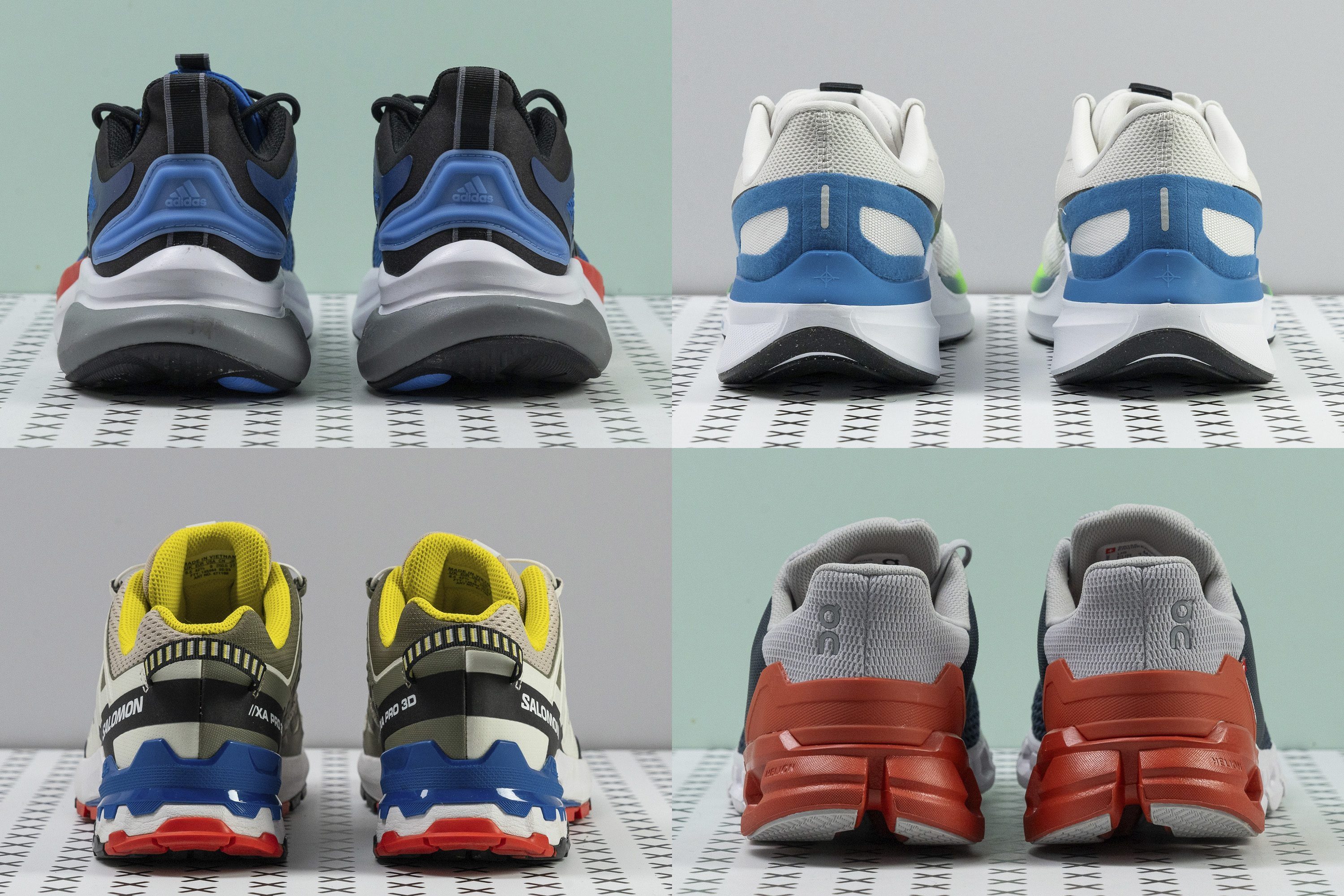
One of our lab tests is heel counter stiffness measurement. We push and squeeze the heel and assess its stiffness on a 1-5 scale, where 5 is the stiffest.
Assessing heel counter stiffness in RunRepeat lab
|
If this topic intrigues you, we recommend digging into our guide: The role of heel counters in running shoes. |
Stiffer shoes are usually better for flat feet
Too much flexibility means your feet have to work more. It also means there’s a more natural feeling when running. However, flat feet often appreciate the extra support and stability and it’s what a stiffer platform can give.
When testing shoes, we perform the longitudinal flexibility and torsional rigidity tests. When testing the longitudinal flexibility, we lock the toebox in place which makes the heel lift slightly due to the forefoot rocker. We adjust the position of the bottom plate so that the heel rests on it. Then, we bend the shoe by 30 degrees. Higher numbers in Newtons mean we needed more force to bend the shoe, which means it’s stiffer.
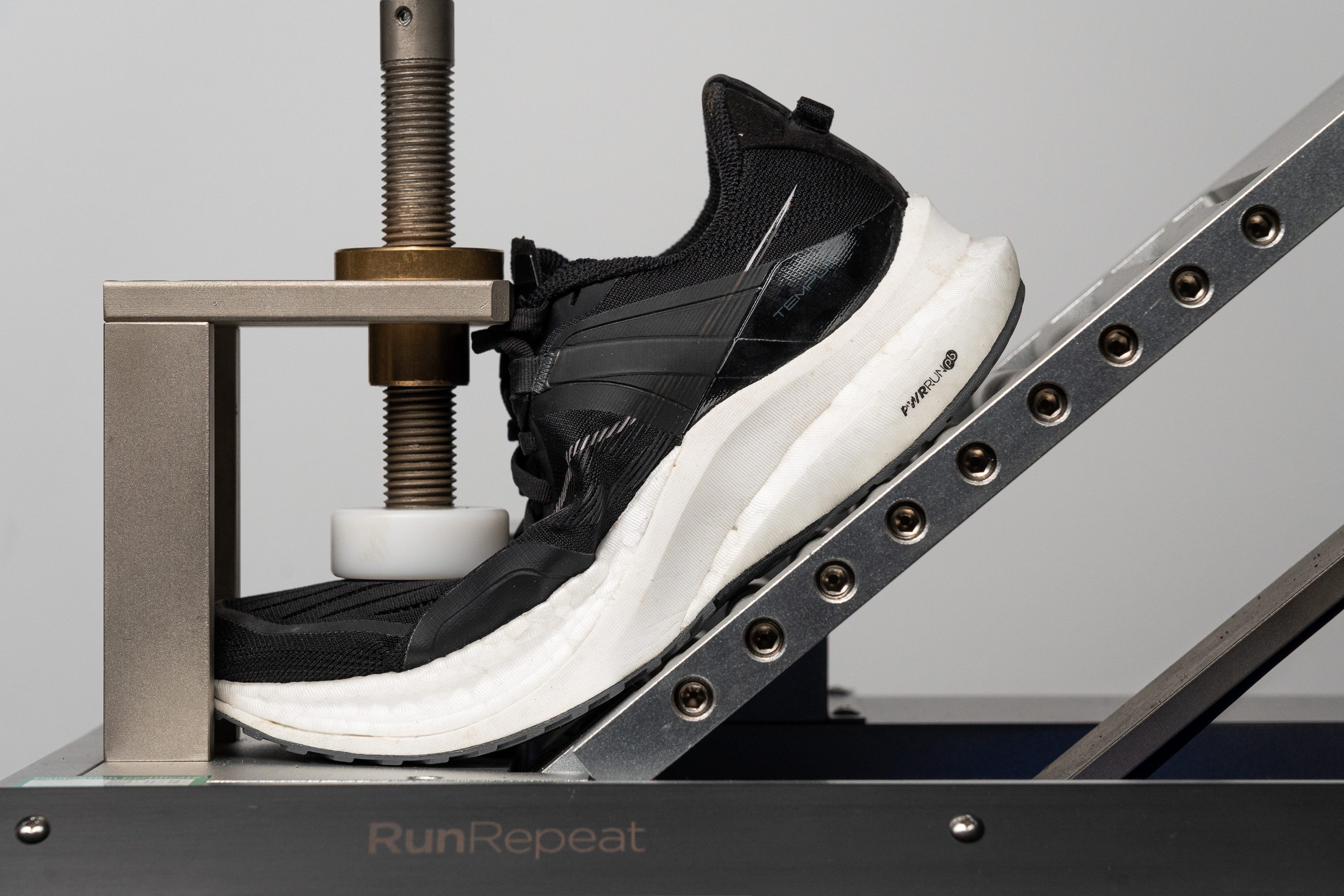
On the other hand, when testing torsional rigidity, we twist the shoe using our hands and assess the rigidity on a 1-5 scale where 5 is the most rigid.
Torsional rigidity assessment
For context, here’s how stiff best-rated running shoes for flat feet are:
Why flexible shoes might not work: flexibility in the midfoot adds more stress to the arch because of the instability. More work for the feet, more stress for the arch = discomfort at least.
The role of heel bevels in running shoes for flat feet
Heel bevels are present when you notice that the back of the heel is curved. This curve serves the purpose of mimicking the shape of the heel because such a heel shape in a running shoe is able to reduce the amount of stress in the tibialis anterior muscle and it improves the transition for heel strikers.
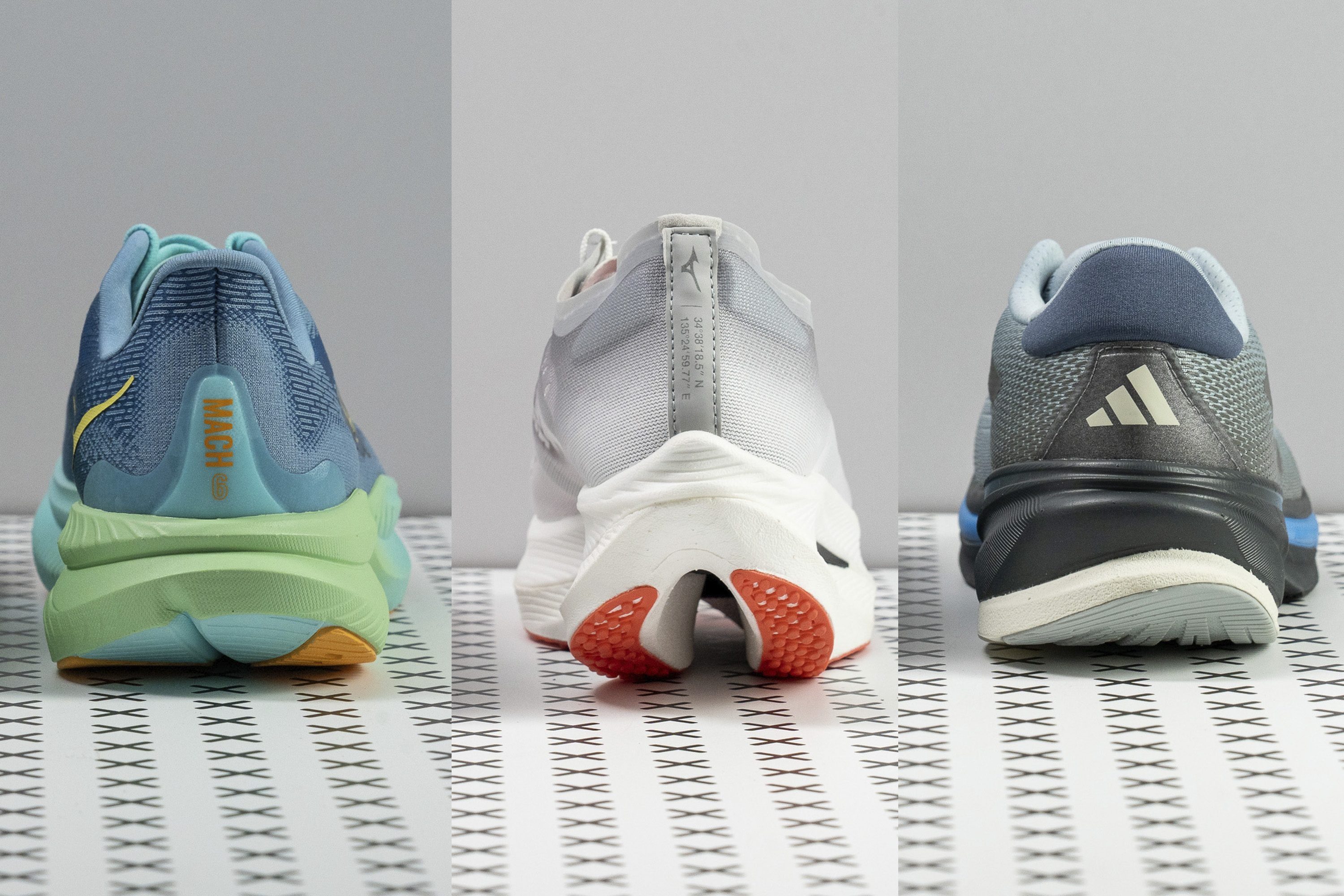
Wide platform and sole flares: very important for stability
Wide platform is a must because it is obviously more stable.
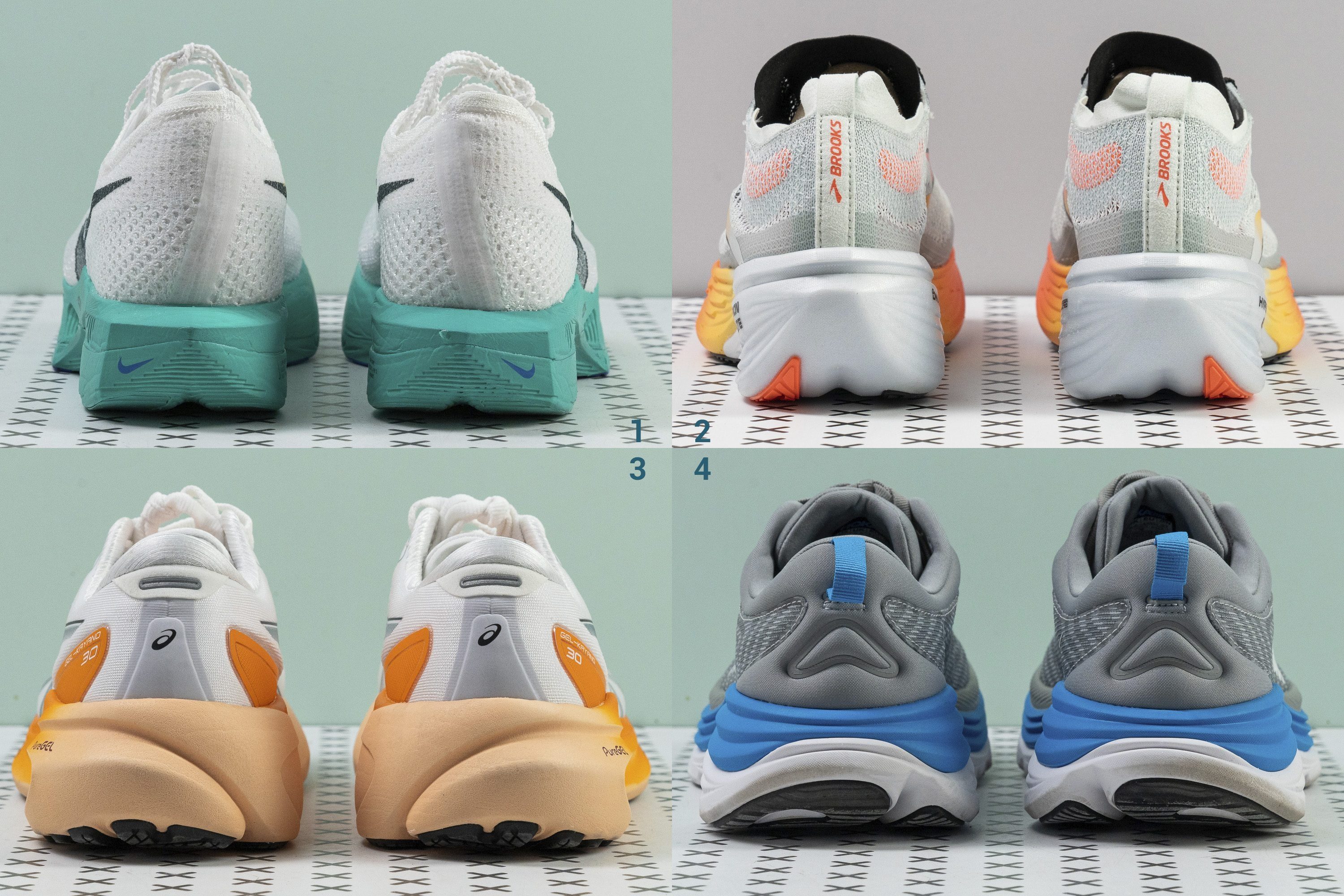
However, what you can also notice on midsoles that seem wide is the sole flare. It’s basically a protrusion of the midsole.
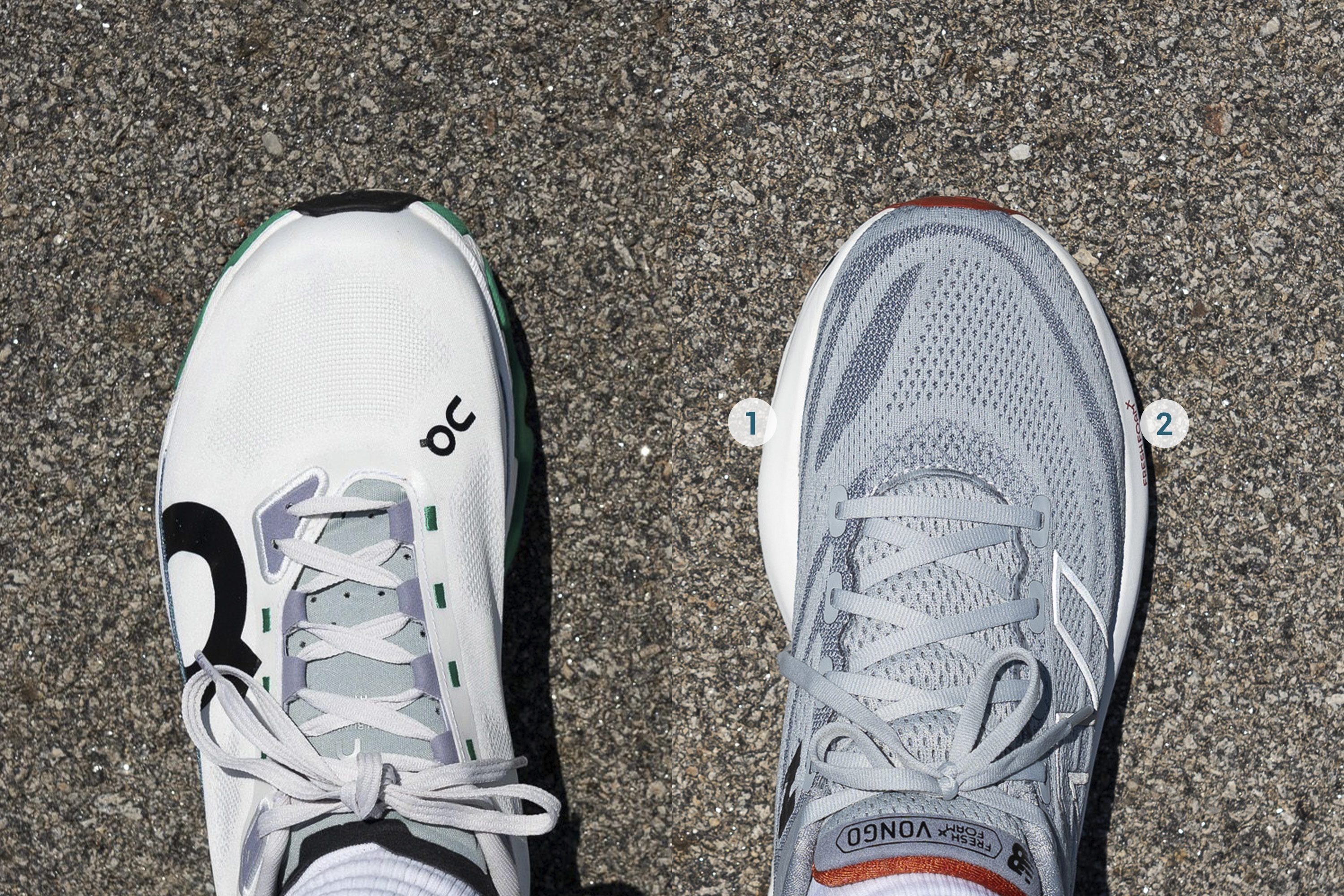
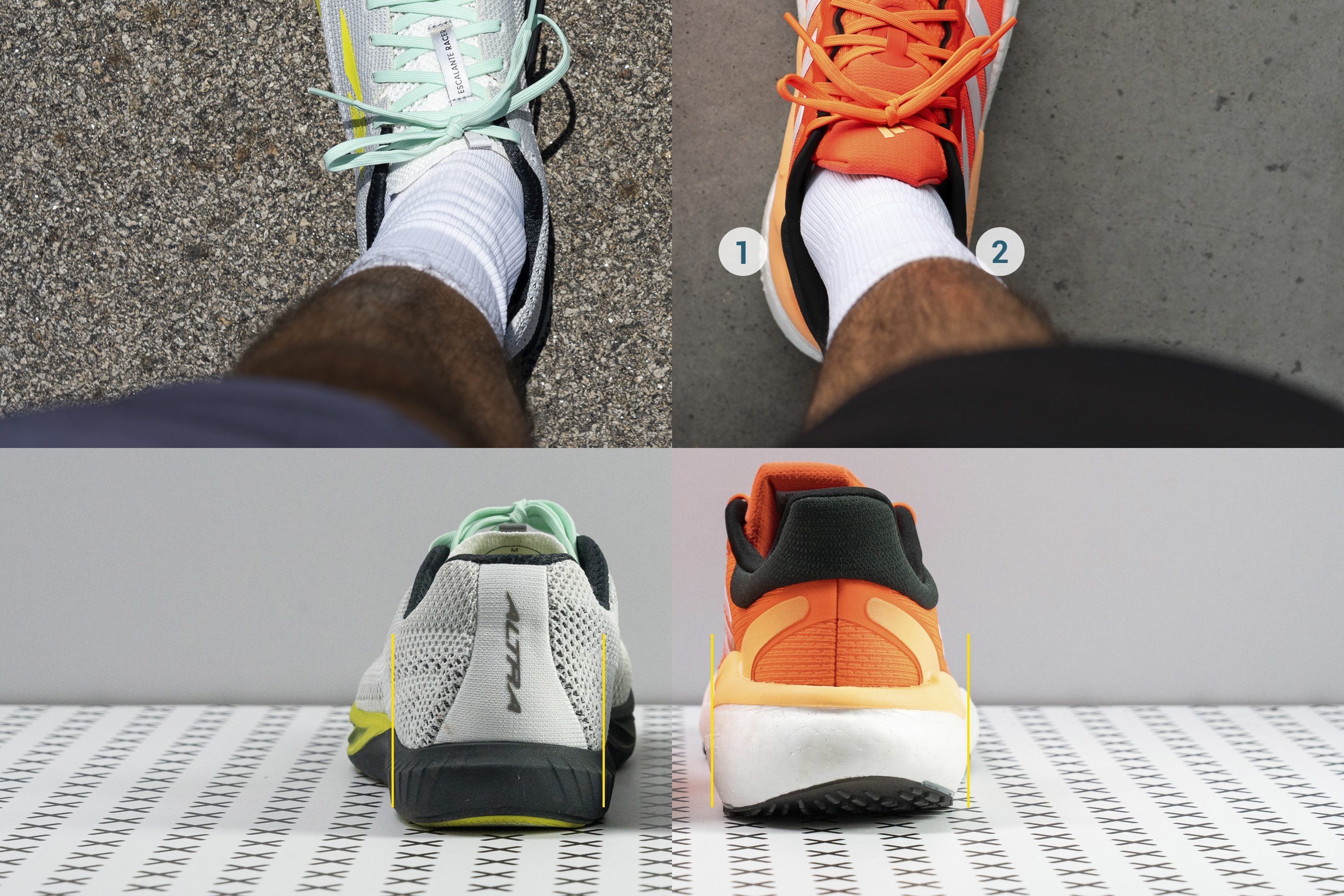
These protrusions help with transitions by adding stability to the landing. Runners who land on the heel look for heel flares while those who land at the forefoot often look for forefoot flares.
When it comes to the width of the platform, in our shoe lab, we measure it in 2 places: at the heel and at the forefoot.
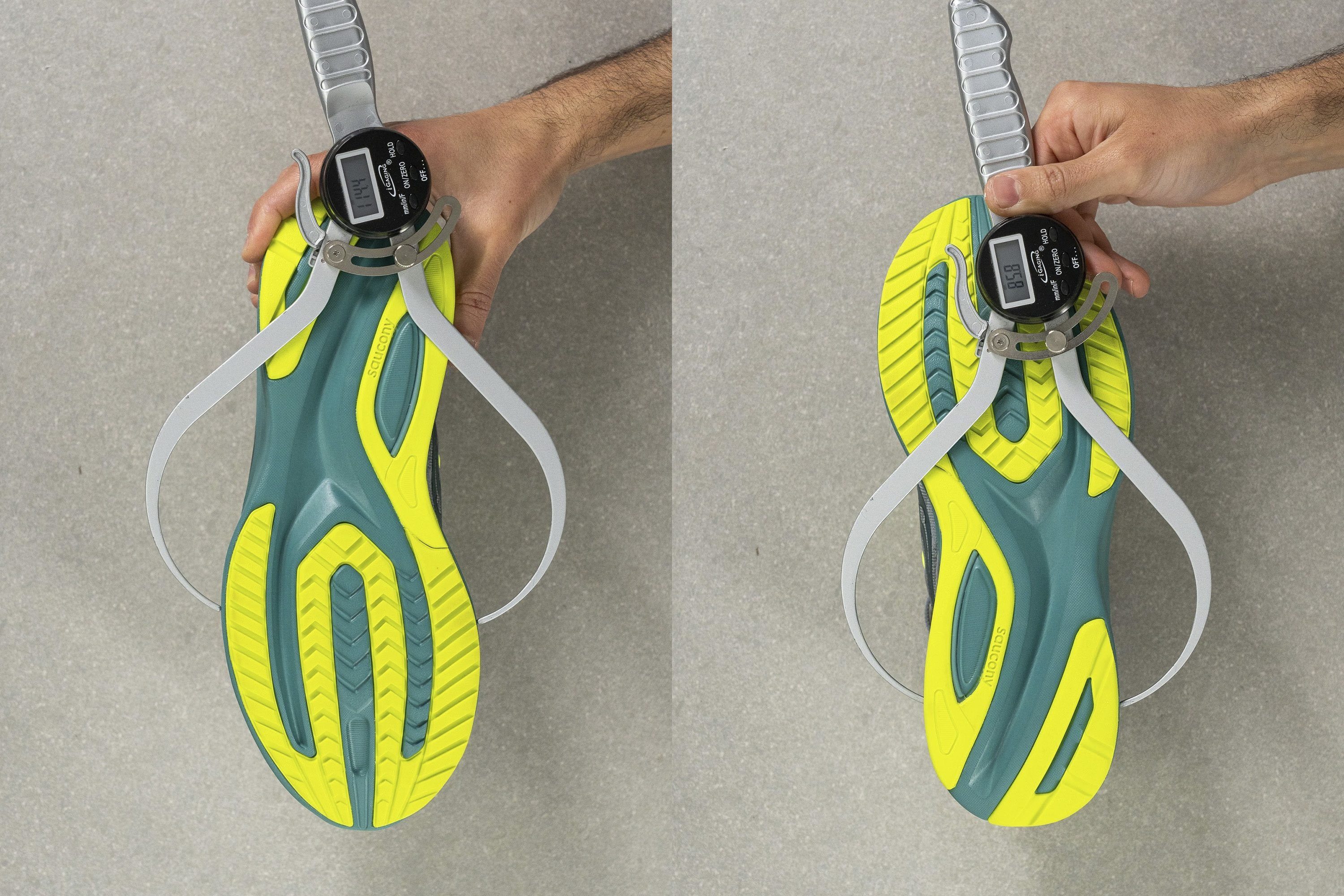
Based on these numbers, you can easily pick a shoe with a wider or narrower platform. For context, here’s how wide the platform is for best-rated shoes for flat feet:
And in case you think that might not be enough, here are the top 5 widest platforms found in running shoes for flat feet:
Upper overlays that stabilize the foot
Some shoes have no overlays. The uppers are soft and more sock-like. Other shoes, who aim to provide an even better lockdown, have firm or stiff overlays that add more structure to the upper.
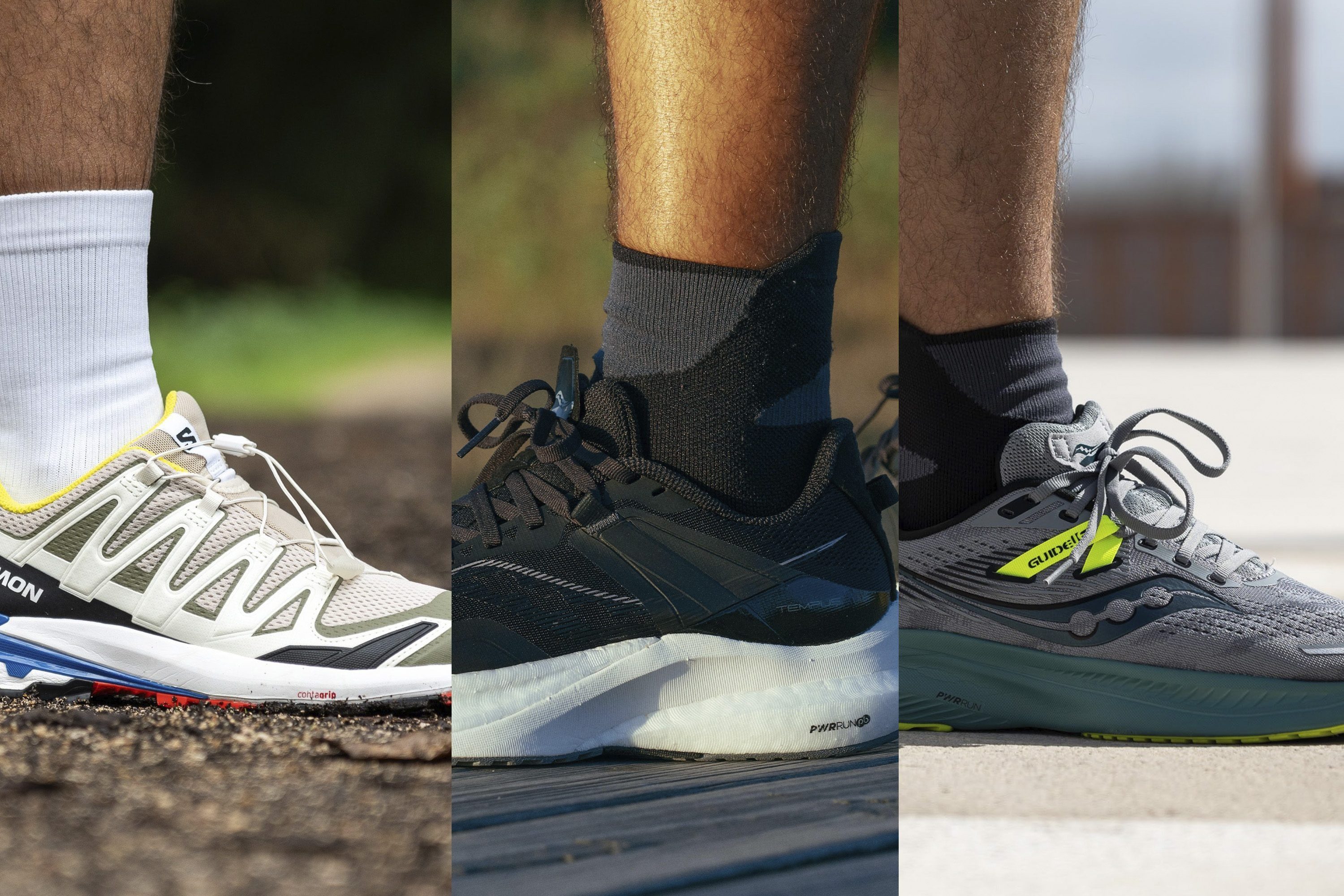
These can help quite a bit when it comes to getting that perfect locked-in feel.
Stability plates
Mizuno is famous for its WavePlate whose task is to stop the arch from collapsing and to offer stability. Below, we see how it looks like in Mizuno Wave Inspire 20.
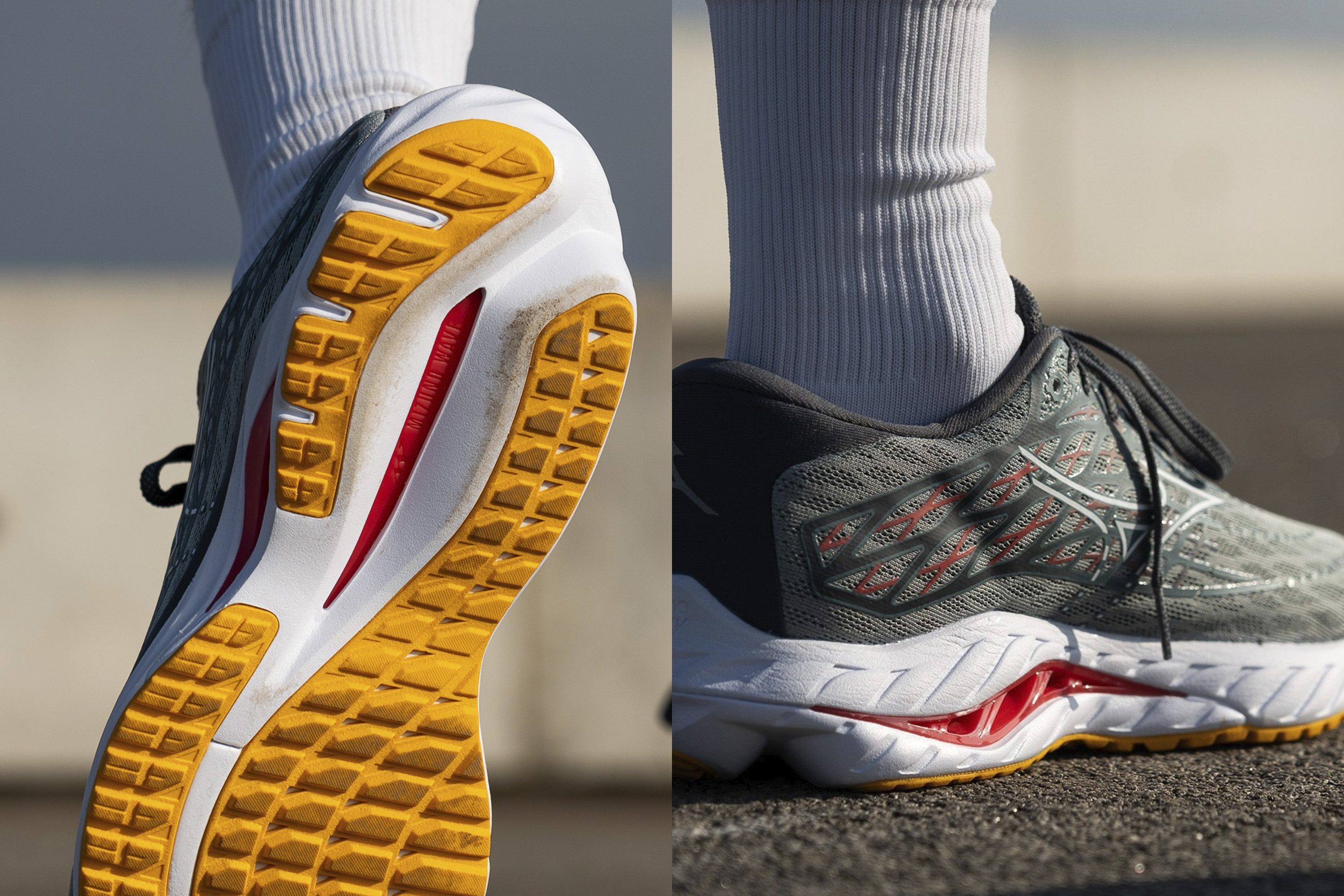
Mizuno also made a variation of this plate with an integrated rubber wall.
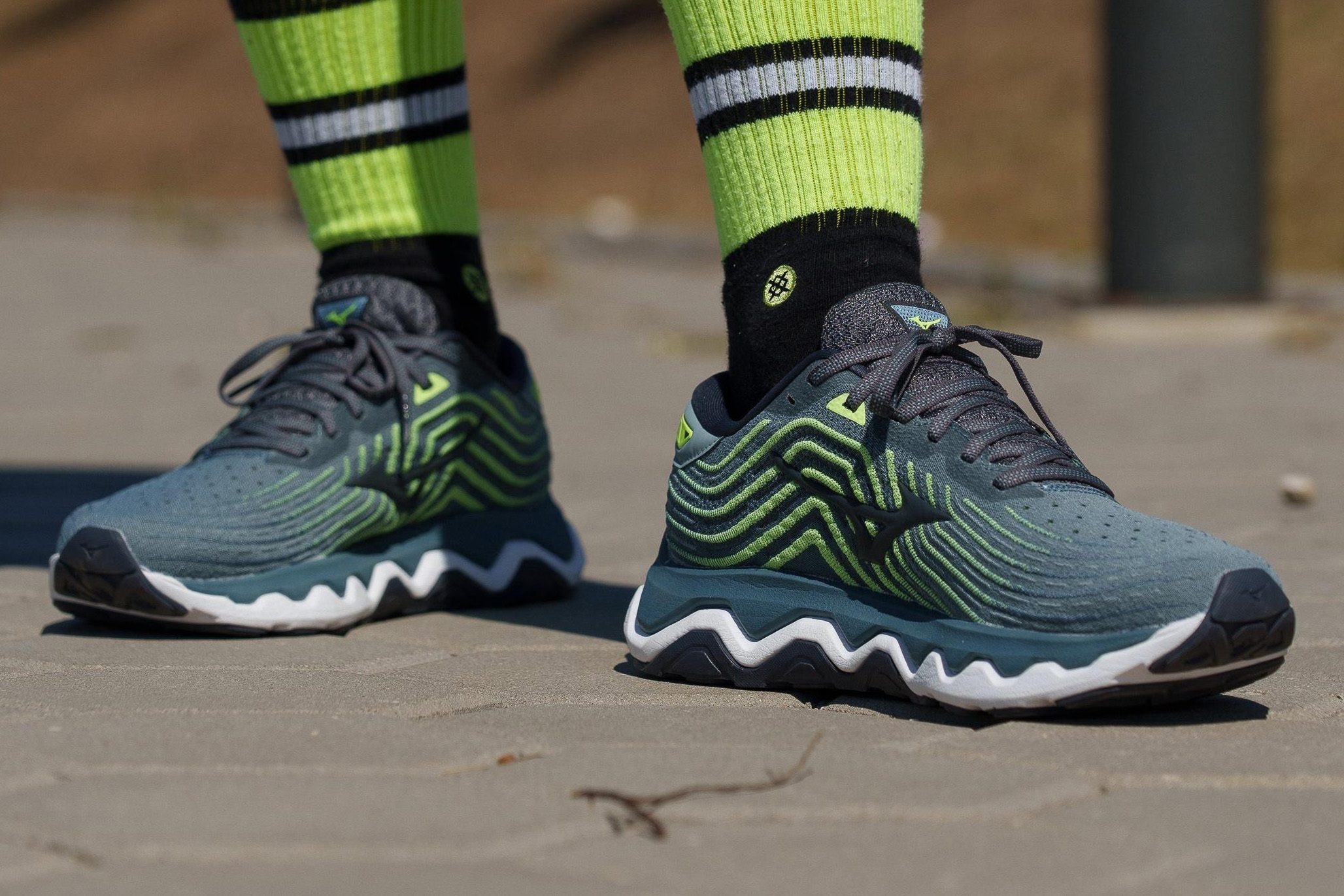
Are there lightweight shoes for flat feet?
Just because these shoes carry more technologies does not mean they have to be very heavy. Stability shoes tend to sacrifice some lightness in return for better stability. Additional supportive features make them heavier than neutral running shoes on average:
|
Neutral running shoes |
Stability running shoes (for flat feet) |
|
|
Average weight |
9.3 oz (263g) |
10 oz (285g) |
But as footwear technologies evolve, brands find new ways to make lighter shoes for flat feet.
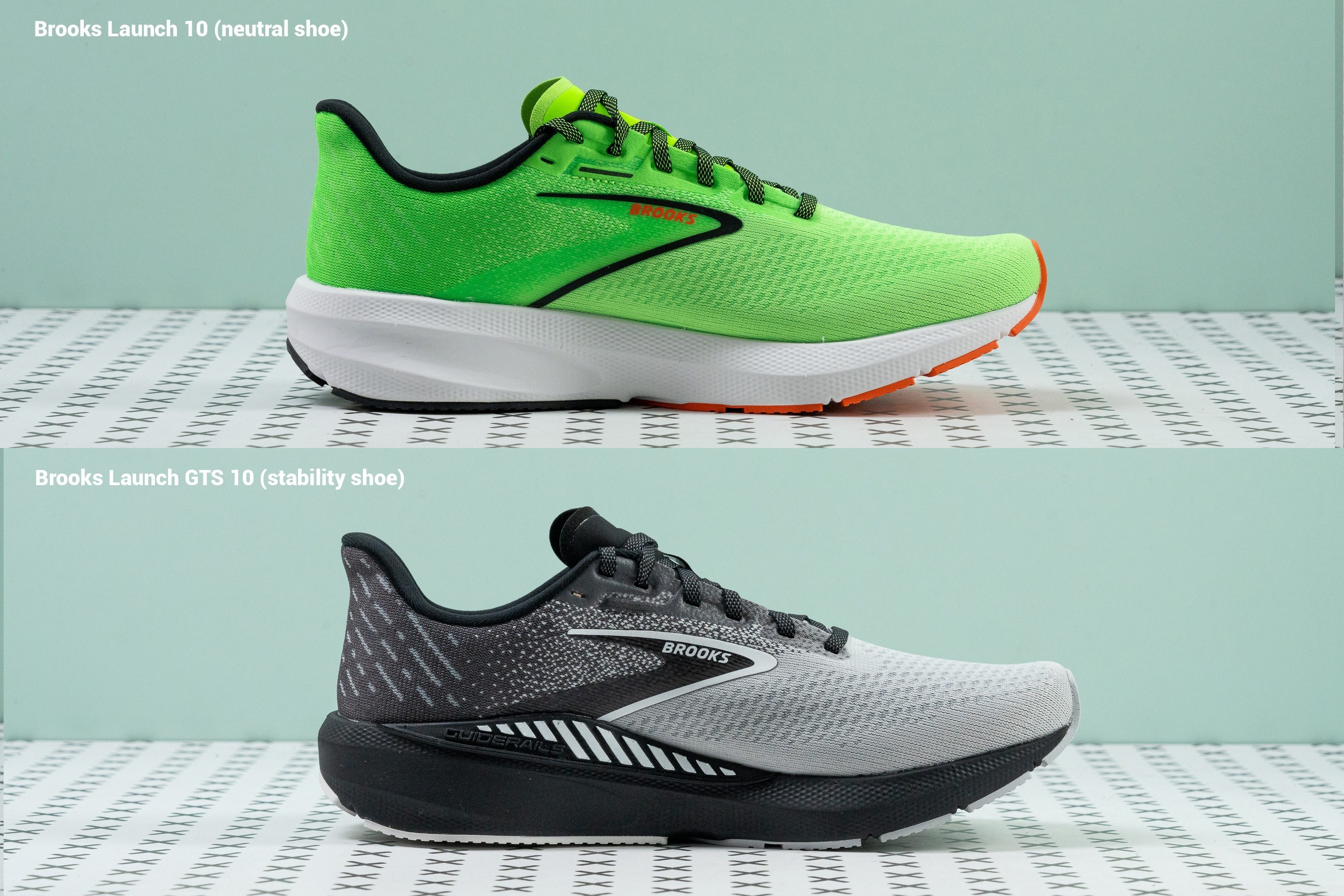
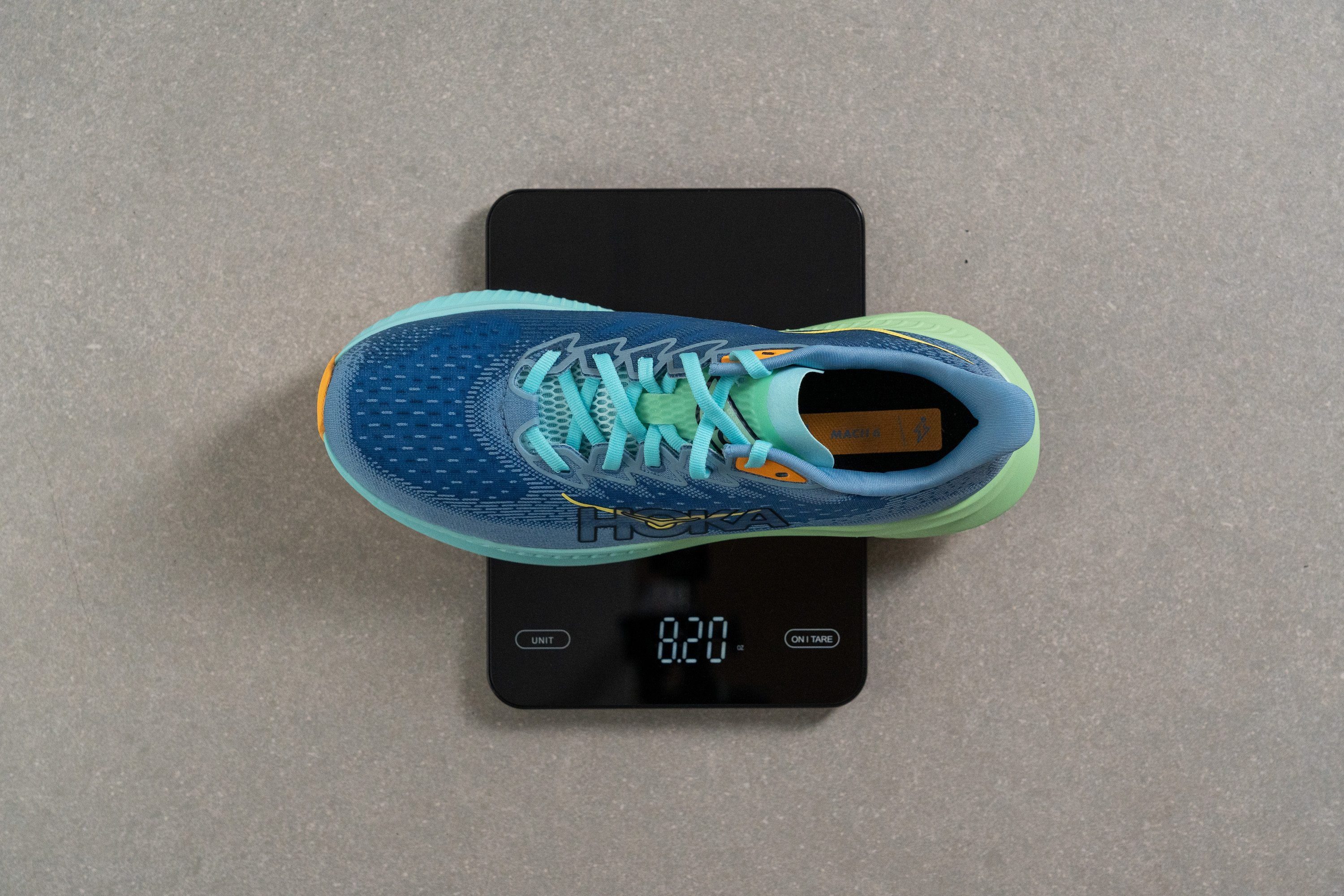
Here’s how heavy the best-rated running shoes for flat feet are:
And, in case you want to go as light as possible, here are the lightest choices! These tables are updated daily, with every review that we publish, so you can rest assured that these are up-to-date.
How durable are running shoes for flat feet?
When durability is discussed, runners most often refer to the outsole. Especially when the landing happens on one side (and not evenly, due to overpronation), outsoles and midsoles can wear out faster.
In our lab, we measure the durability of the outsole using a Dremel. We press it against the outsole and it’s a standardized test: always the same force, RPMs and duration.
Outsole durability test
Once the damage is done, we use a tire tread gauge to measure how deep the dent is. The shallower the dent, the more durable the outsole!
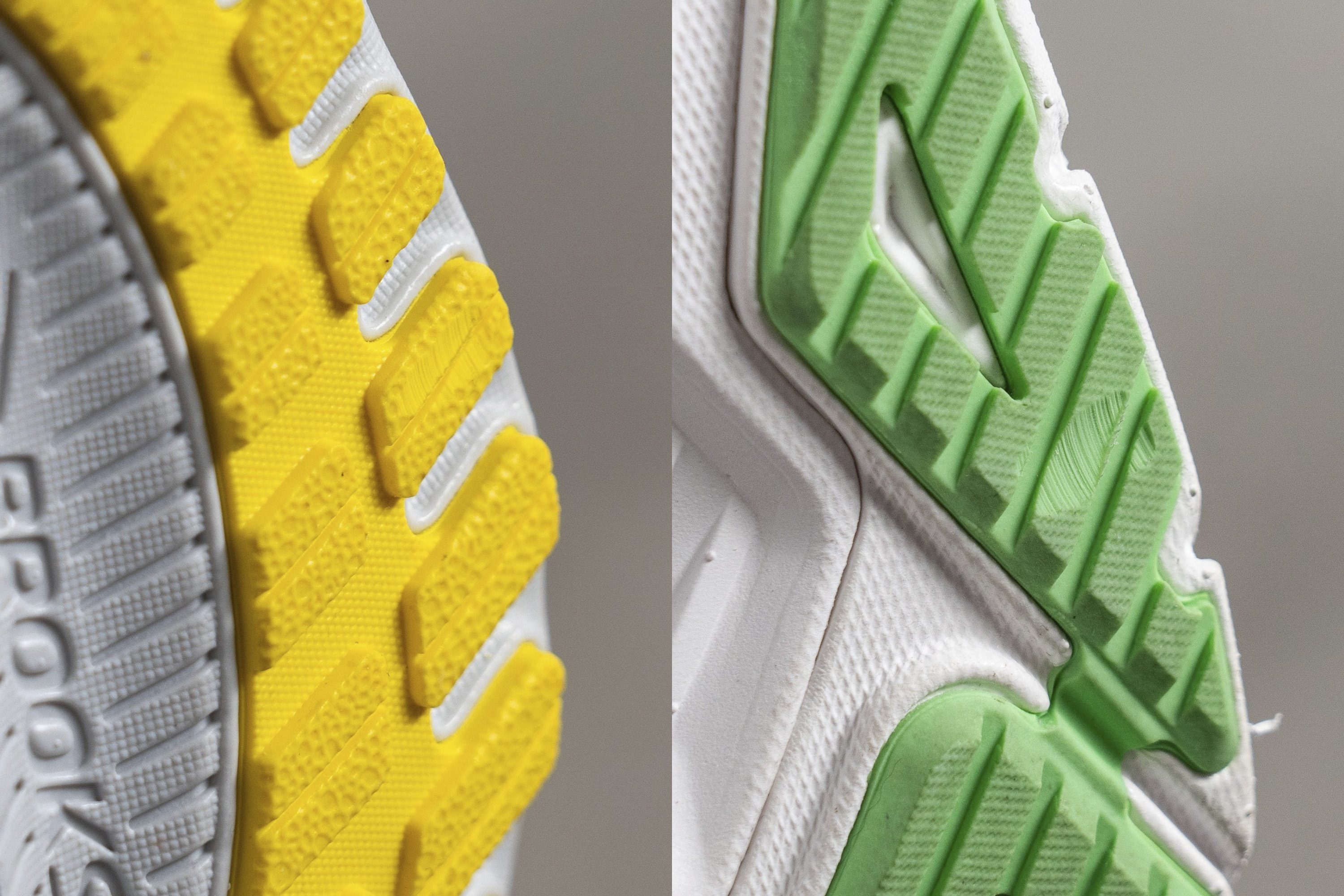
If this is something that worries you, look at the shoes that performed the best on our outsole durability test.
We also perform the upper durability test and the heel padding durability test. We again use the Dremel and, after the damage has been done, we assess it on a 1-5 scale, where 1 is the least durable.
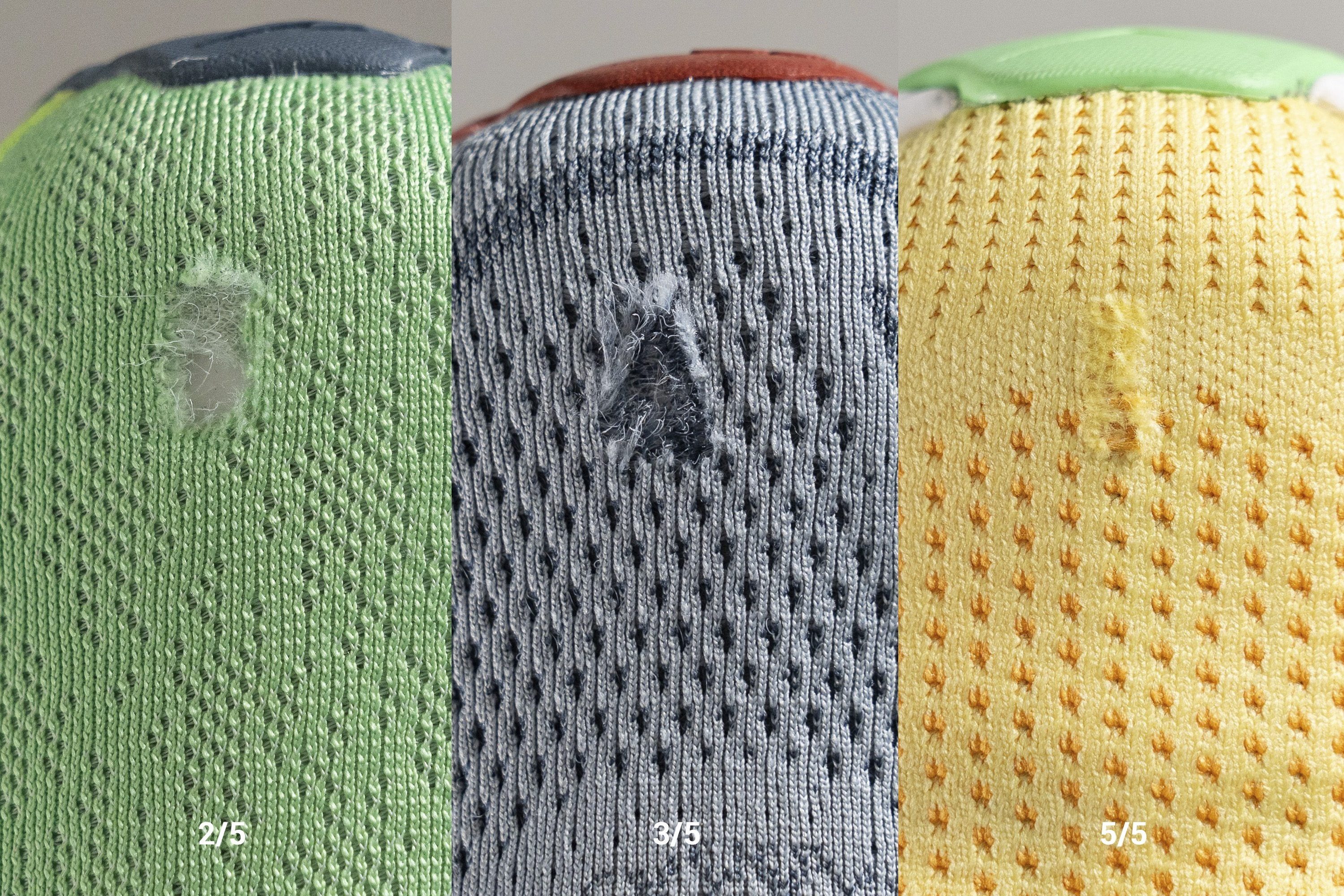
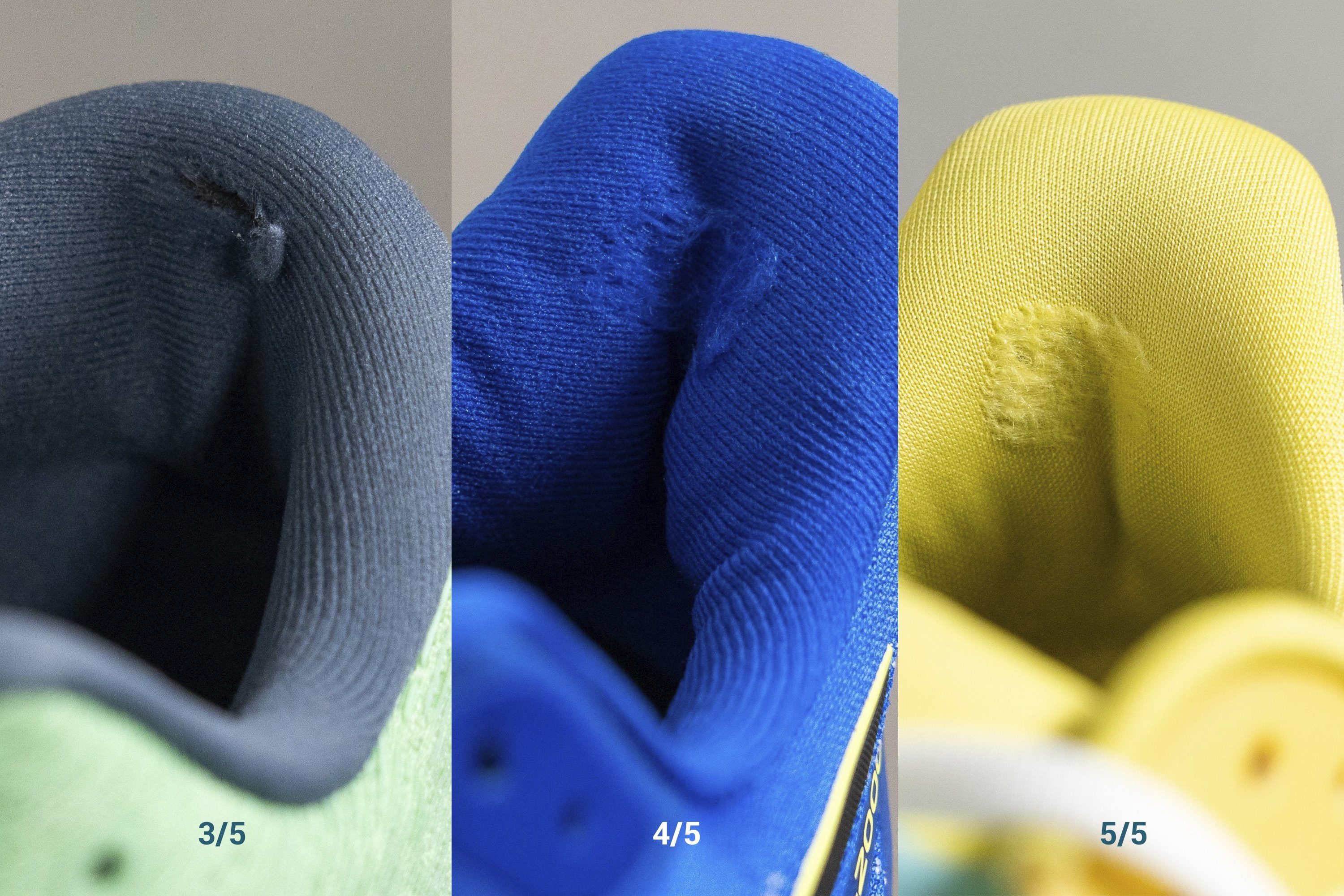
Here’s an overview of all 3 durability tests in best-rated running shoes for flat feet:
Wide and flat feet? No problem!
Before talking about measurements, we advise understanding where your toes need more room: where the shoe is the widest or at the big toe. As shown in the illustration above, some shapes (like Greek, Egyptian) need more room at the ball of the foot, while other shapes need more room at the big toe.
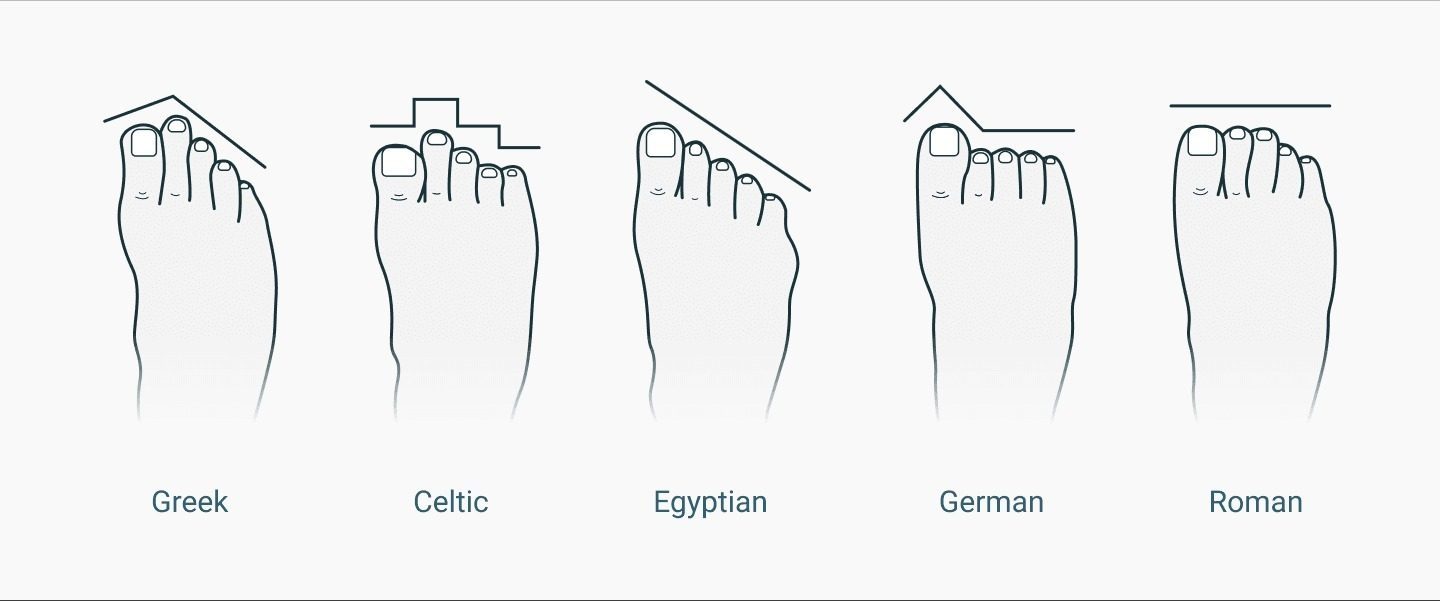
Now that you know that there are 2 points of measurement of the width, we can talk about our lab tests.
To get accurate toebox measurements, we pour a special gel into the shoe and then freeze them together. This allows us to get a gel mold that perfectly resembles the shoe's interior
Once the gel hardens, we can play around with the mold and take measurements.
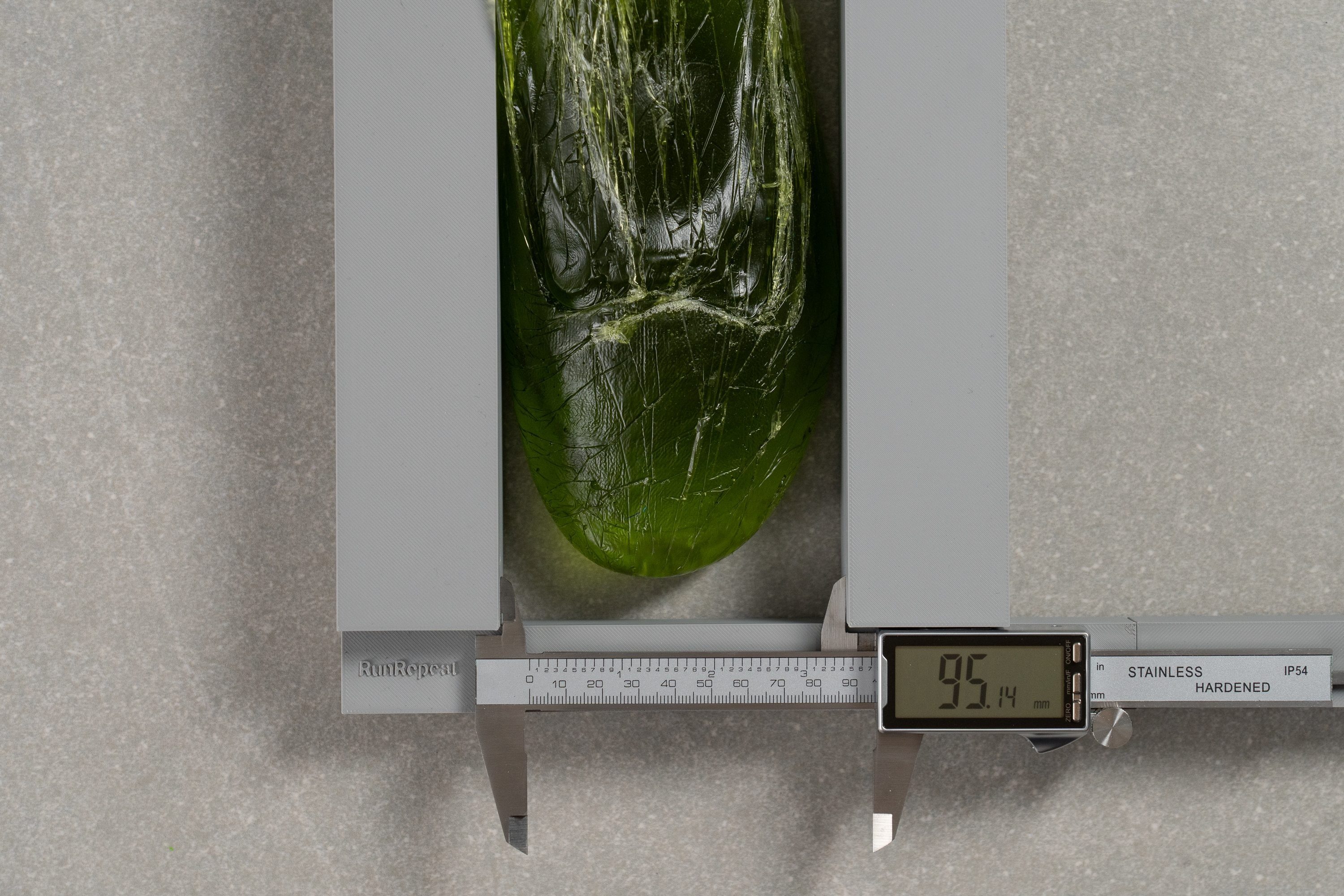
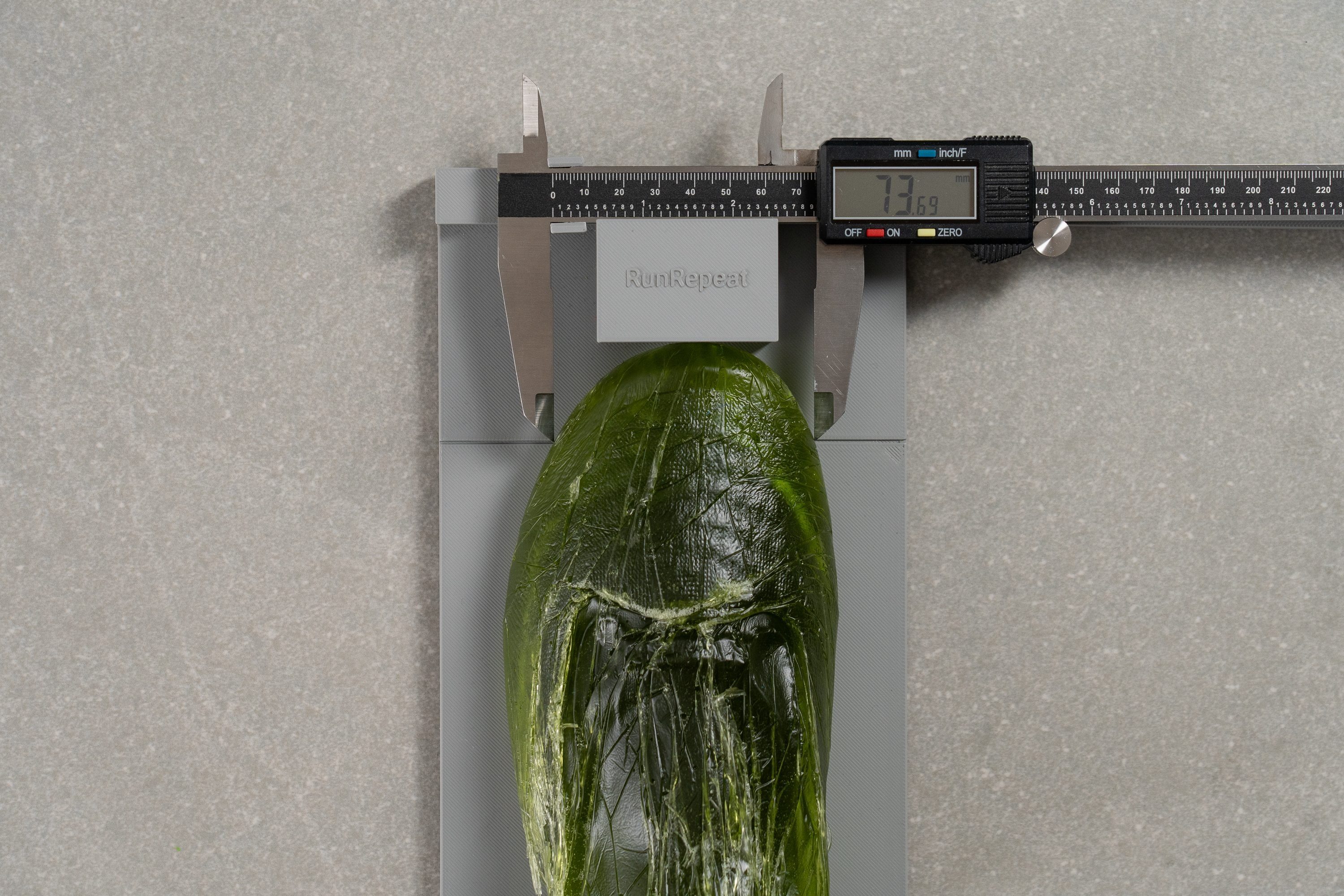
This gel mold is great because it fills the interior of the toebox completely. So, we don't measure only the width of the toebox, but also its height.
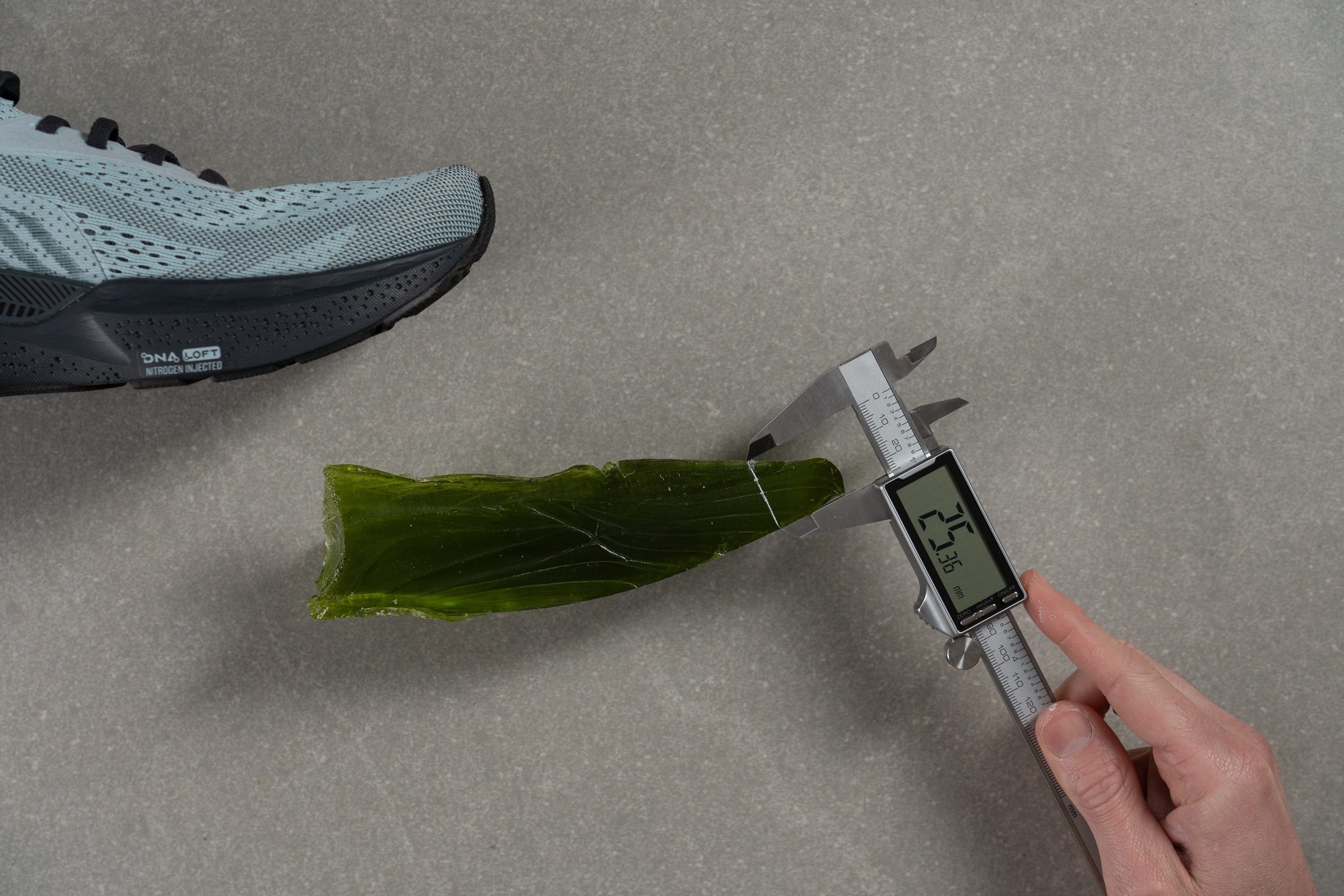
Knowing the height of the toebox is very valuable for runners who often experience pressure in the toebox due to the upper pressing on their toenails.
Best heel drop for flat feet
Another essential parameter to consider is the heel-to-toe drop (the difference between the heel and forefoot stack height).
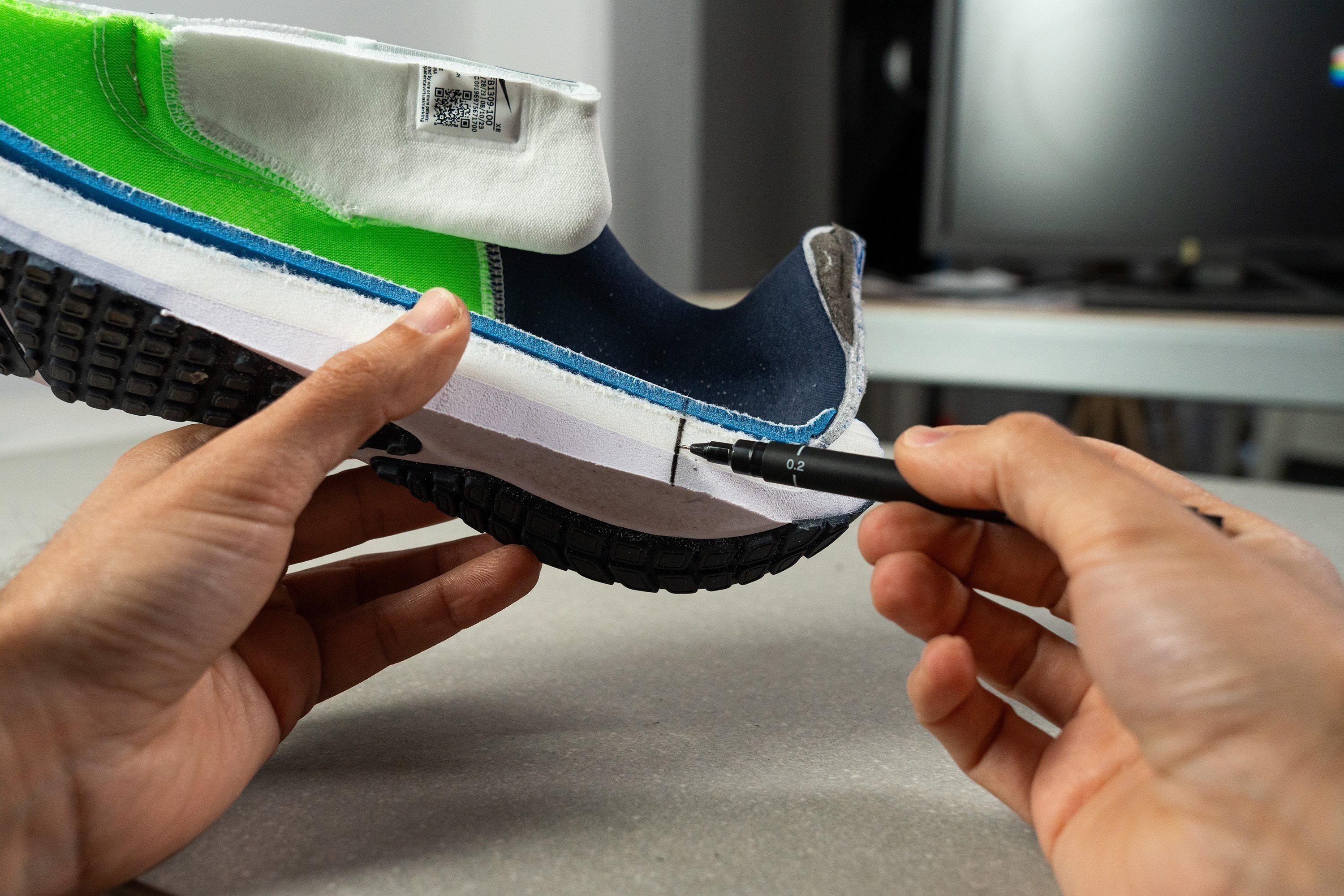
The majority of running shoes for flat feet have a heel drop of 8 mm or more which means that there is more cushioning under the heel compared to the forefoot. This setup favors a heel-striking pattern when the heel is the first part of the foot to land on the ground. That’s the most common pattern among beginners and most runners.

Midfoot and forefoot strikers with flat feet can also find a suitable shoe for their needs. Just make sure that the shoe’s drop is lower than 8 mm:
If you are not sure about your striking pattern or want to know more about the effect of drop, see our guide on the topic.
Consider breathability as well
We perform a series of tests to determine the shoe’s ventilation capacities, including a smoke-pumping test and a transparency test.
Breathability test performed in RunRepeat lab using a smoke machine
Based on our findings, we rate each shoe’s breathability on a 1-5 scale where 5 is the most breathable. Here are flat-feet shoes that we found to breathe well:
Stretch and strengthen your feet
If you have flat feet, keep your arches strong and properly stretched. Make sure to stretch regularly every day for a few minutes and after your running activity.
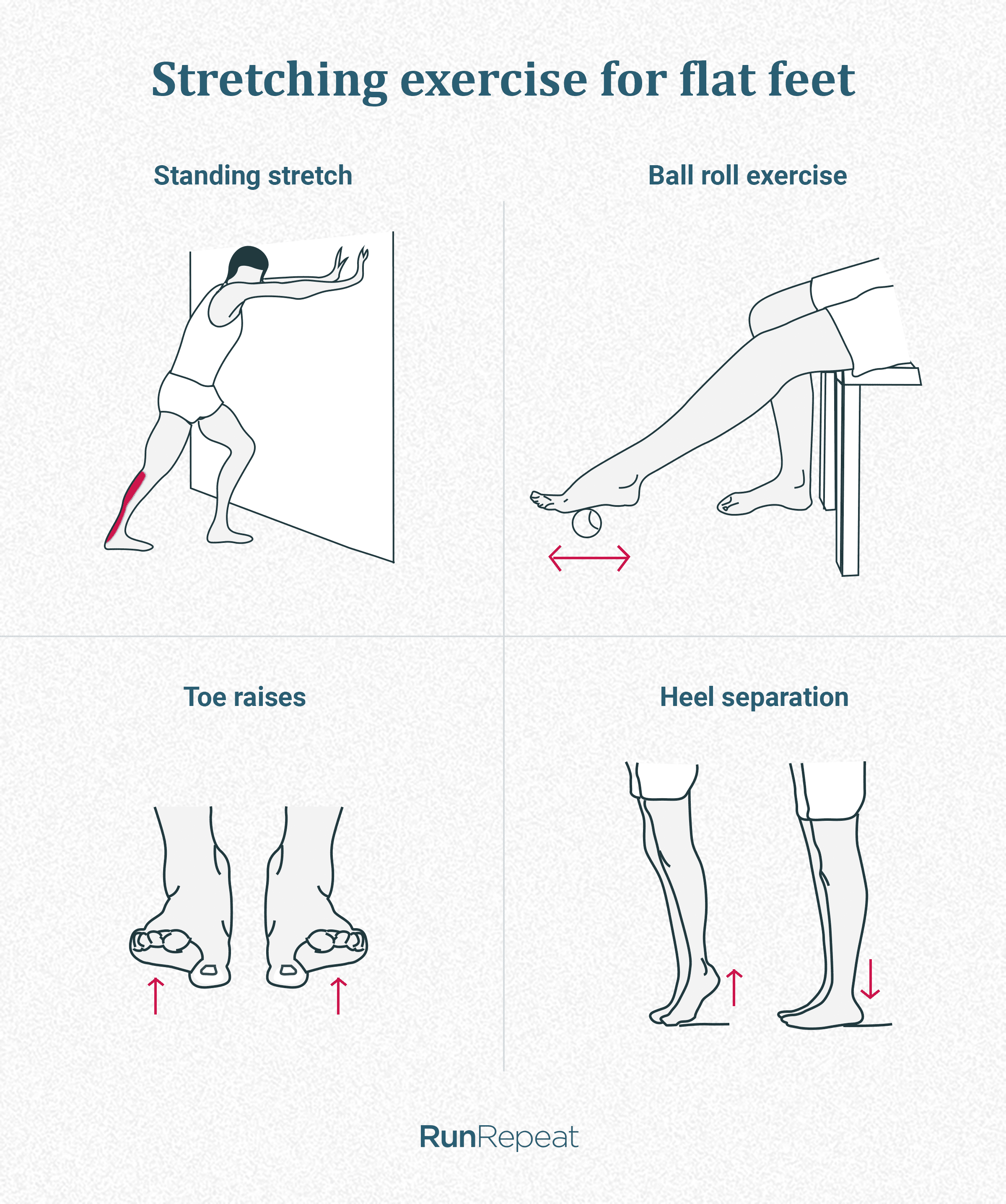
For instructions and more flat feet exercises, read this article.
Do not ignore the pain
Running through pain will worsen the condition and increase the risk of serious injury. If you experience pain while running, get professional help. It is important to rest too.

